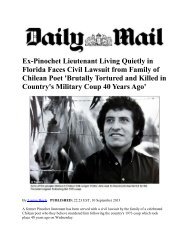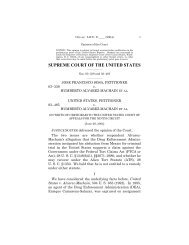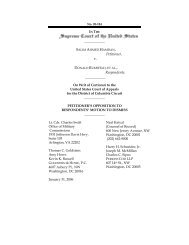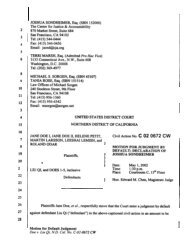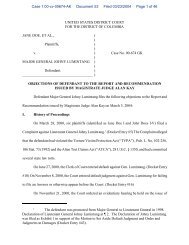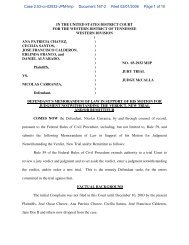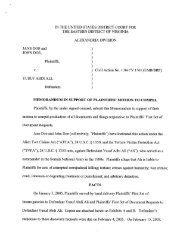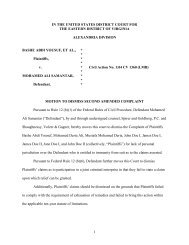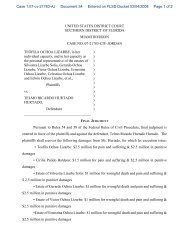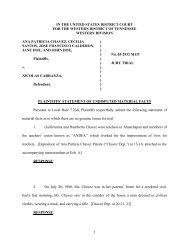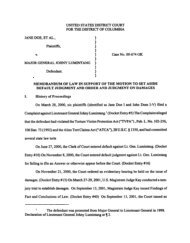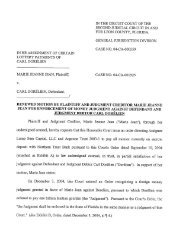Memo of Law on Damages and Closing Statement - Center for ...
Memo of Law on Damages and Closing Statement - Center for ...
Memo of Law on Damages and Closing Statement - Center for ...
You also want an ePaper? Increase the reach of your titles
YUMPU automatically turns print PDFs into web optimized ePapers that Google loves.
Case 1:07-cv-21783-AJ Document 32 Entered <strong>on</strong> FLSD Docket 02/29/2008 Page 1 <str<strong>on</strong>g>of</str<strong>on</strong>g> 31UNITED STATES DISTRICT COURTFOR THE SOUTHERN DISTRICT OF FLORIDAMIAMI DIVISIONCASE NO. 07-21783-CIV-JORDANTEÓFILA OCHOA LIZARBE, in herindividual capacity, <strong>and</strong> in her capacity as thepers<strong>on</strong>al representative <str<strong>on</strong>g>of</str<strong>on</strong>g> the estates <str<strong>on</strong>g>of</str<strong>on</strong>g>Silvestra Lizarbe Solis, Gerardo OchoaLizarbe, Victor Ochoa Lizarbe, ErnestinaOchoa Lizarbe, Celestino Ochoa Lizarbe, <strong>and</strong>Edwin Ochoa Lizarbe, <strong>and</strong>CIRILA PULIDO BALDEÓN, in herindividual capacity, <strong>and</strong> in her capacity as thepers<strong>on</strong>al representative <str<strong>on</strong>g>of</str<strong>on</strong>g> the estates <str<strong>on</strong>g>of</str<strong>on</strong>g>Fortunata Baldeón Gutiérrez <strong>and</strong> Edgar PulidoBaldeón,v.Plaintiffs,TELMO RICARDO HURTADO HURTADO,Defendant./PLAINTIFFS’ MEMORANDUM OF LAW ONDAMAGES AND CLOSING STATEMENTPlaintiffs, Teófila Ochoa Lizarbe <strong>and</strong> Cirilia Pulido Baldeón, (collectively,“Plaintiffs”), submit their <str<strong>on</strong>g>Memo</str<strong>on</strong>g>r<strong>and</strong>um <str<strong>on</strong>g>of</str<strong>on</strong>g> <str<strong>on</strong>g>Law</str<strong>on</strong>g> <strong>on</strong> <strong>Damages</strong> <strong>and</strong> their <strong>Closing</strong> <strong>Statement</strong> <strong>for</strong> thetrial held <strong>on</strong> February 11, 2008. The Plaintiffs brought two claims against Defendant TelmoRicardo Hurtado Hurtado (“Hurtado” or “Defendant”) – <strong>on</strong>e under the Alien Tort Statute(“ATS”) (Counts I –VII) <strong>and</strong> the other under the Torture Victim Protecti<strong>on</strong> Act (“TVPA”)(Counts I-III). The claims were brought <strong>on</strong> behalf <str<strong>on</strong>g>of</str<strong>on</strong>g> the Plaintiffs individually, <strong>and</strong> <strong>on</strong> behalf <str<strong>on</strong>g>of</str<strong>on</strong>g>the Plaintiffs’ deceased mothers <strong>and</strong> six deceased siblings. As this Court has entered default
Case 1:07-cv-21783-AJ Document 32 Entered <strong>on</strong> FLSD Docket 02/29/2008 Page 4 <str<strong>on</strong>g>of</str<strong>on</strong>g> 31decided ATS <strong>and</strong> TVPA cases, to craft a remedy that will appropriately compensate Plaintiffs<strong>and</strong> punish Hurtado.Because Hurtado’s human rights abuses occurred in Peru, against Peruviancitizens, the Court may look to the laws <str<strong>on</strong>g>of</str<strong>on</strong>g> Peru to determine if there are additi<strong>on</strong>al remedies ordamages that should be c<strong>on</strong>sidered in order to effectuate the purpose <str<strong>on</strong>g>of</str<strong>on</strong>g> internati<strong>on</strong>al law <strong>and</strong> itsnorms, <strong>and</strong> to compensate victims <str<strong>on</strong>g>of</str<strong>on</strong>g> murder <strong>and</strong> torture. Although it does not refer specificallyto “compensatory” or “punitive” damages, the law <str<strong>on</strong>g>of</str<strong>on</strong>g> Peru permits courts to award damages tocompensate victims <strong>for</strong> pain <strong>and</strong> suffering; to punish perpetrators <str<strong>on</strong>g>of</str<strong>on</strong>g> tortious c<strong>on</strong>duct; <strong>and</strong> todeter others from such tortious c<strong>on</strong>duct. Because the law <str<strong>on</strong>g>of</str<strong>on</strong>g> Peru is c<strong>on</strong>sistent with the federalcomm<strong>on</strong> law <str<strong>on</strong>g>of</str<strong>on</strong>g> damages in tort, this Court need not apply Peruvian law to determine an award<str<strong>on</strong>g>of</str<strong>on</strong>g> damages.The federal comm<strong>on</strong> law <str<strong>on</strong>g>of</str<strong>on</strong>g> the ATS <strong>and</strong> the TVPA <strong>and</strong> Peruvian law <strong>on</strong> damages(described herein) reflect virtually identical principles, such that no real c<strong>on</strong>flict exists betweenthose laws – further supporting reference to both or either set <str<strong>on</strong>g>of</str<strong>on</strong>g> laws in fashi<strong>on</strong>ing acompensatory <strong>and</strong> punitive damages award. The law <str<strong>on</strong>g>of</str<strong>on</strong>g> Florida has no applicati<strong>on</strong> to this case,<strong>and</strong> Florida laws <strong>and</strong> statutes (wr<strong>on</strong>gful death laws <strong>and</strong> otherwise) should not be c<strong>on</strong>sidered.In c<strong>on</strong>clusi<strong>on</strong>, as a <strong>Closing</strong> <strong>Statement</strong>, Plaintiffs provide a factual summary <str<strong>on</strong>g>of</str<strong>on</strong>g>how this law should apply to the evidence presented during the trial <strong>on</strong> damages.II.Federal Comm<strong>on</strong> <str<strong>on</strong>g>Law</str<strong>on</strong>g> Applies to the Assessment <str<strong>on</strong>g>of</str<strong>on</strong>g> <strong>Damages</strong> Under Both the ATS<strong>and</strong> the TVPAIn determining damages, this Court should apply federal comm<strong>on</strong> law toPlaintiffs’ claims under the ATS <strong>and</strong> the TVPA. Claims under the ATS <strong>and</strong> the TVPA arepredicated <strong>on</strong> federal questi<strong>on</strong> jurisdicti<strong>on</strong>. In cases arising under federal jurisdicti<strong>on</strong>, federal4
Case 1:07-cv-21783-AJ Document 32 Entered <strong>on</strong> FLSD Docket 02/29/2008 Page 5 <str<strong>on</strong>g>of</str<strong>on</strong>g> 31comm<strong>on</strong> law applies to the choice-<str<strong>on</strong>g>of</str<strong>on</strong>g>-law determinati<strong>on</strong>. See Chan v. Soc’y Expediti<strong>on</strong>s, Inc.,123 F.3d 1287, 1297 (9th Cir. 1997).A. Federal Comm<strong>on</strong> <str<strong>on</strong>g>Law</str<strong>on</strong>g>1. Federal Choice <str<strong>on</strong>g>of</str<strong>on</strong>g> <str<strong>on</strong>g>Law</str<strong>on</strong>g> AnalysisFederal courts have yet to articulate a c<strong>on</strong>sistent choice-<str<strong>on</strong>g>of</str<strong>on</strong>g>-law analysis <strong>for</strong> thedeterminati<strong>on</strong> <str<strong>on</strong>g>of</str<strong>on</strong>g> damages in ATS <strong>and</strong> TVPA cases. Few courts have explicitly addressed thequesti<strong>on</strong> <str<strong>on</strong>g>of</str<strong>on</strong>g> what law applies to damages under the ATS or the TVPA. A review <str<strong>on</strong>g>of</str<strong>on</strong>g> the decisi<strong>on</strong>saddressing the choice <str<strong>on</strong>g>of</str<strong>on</strong>g> law applicable to damages under the ATS or the TVPA, however,dem<strong>on</strong>strates that federal comm<strong>on</strong> law is the appropriate choice. 1The first court to c<strong>on</strong>duct a detailed choice-<str<strong>on</strong>g>of</str<strong>on</strong>g>-law analysis <strong>for</strong> damages under theATS was Filartiga v. Peña-Irala (“Filartiga II”), 577 F. Supp. 860 (E.D.N.Y. 1984). TheFilartiga II court found that almost all the c<strong>on</strong>tacts relevant to the choice <str<strong>on</strong>g>of</str<strong>on</strong>g> law analysis tookplace in Paraguay, <strong>and</strong> so Paraguayan law applied to the award <str<strong>on</strong>g>of</str<strong>on</strong>g> compensatory damages. Butbecause Paraguay did not recognize punitive damages, the Filartiga II court held that federalcomm<strong>on</strong> law, which included principles <str<strong>on</strong>g>of</str<strong>on</strong>g> internati<strong>on</strong>al law, applied to its award <str<strong>on</strong>g>of</str<strong>on</strong>g> punitivedamages. Id. at 865. The court held that this was warranted in order to “give effect to the1Sosa v. Alvarez-Machain, 542 U.S. 692 (2004) is the <strong>on</strong>ly Supreme Court case to address the ATS. Sosaheld that the ATS is <strong>on</strong>ly a jurisdicti<strong>on</strong>al grant but it does not address the applicable law <strong>for</strong> damages under theATS. Id. 713. There are, however, several findings in the opini<strong>on</strong> that impliedly support the applicability <str<strong>on</strong>g>of</str<strong>on</strong>g> federallaw to ATS <strong>and</strong> TVPA claims.First, the Court held that “the jurisdicti<strong>on</strong>al grant (in the ATS) is best read as having been enacted <strong>on</strong> theunderst<strong>and</strong>ing that the comm<strong>on</strong> law would provide a cause <str<strong>on</strong>g>of</str<strong>on</strong>g> acti<strong>on</strong> <strong>for</strong> the modest number <str<strong>on</strong>g>of</str<strong>on</strong>g> internati<strong>on</strong>al lawviolati<strong>on</strong>s with a potential <strong>for</strong> pers<strong>on</strong>al liability at the time.” Id. at 724. This implies that internati<strong>on</strong>al law is a part<str<strong>on</strong>g>of</str<strong>on</strong>g> the comm<strong>on</strong> law. Sec<strong>on</strong>d, the Court states that “in most cases where a court is asked to state or <strong>for</strong>mulate acomm<strong>on</strong> law principle in a new c<strong>on</strong>text, there is a general underst<strong>and</strong>ing that the law is not so much found ordiscovered as it is either made or created.” This acknowledges that federal courts may play an active role infashi<strong>on</strong>ing the comm<strong>on</strong> law in areas under the oversight <str<strong>on</strong>g>of</str<strong>on</strong>g> federal courts – such as claims brought under the ATS.Third, the Court found that “a clear m<strong>and</strong>ate appears in the Torture Victim Preventi<strong>on</strong> Act <str<strong>on</strong>g>of</str<strong>on</strong>g> 1991, 106 Stat 73,providing authority that ‘establish[es] an unambiguous <strong>and</strong> modern basis <strong>for</strong>’ federal claims <str<strong>on</strong>g>of</str<strong>on</strong>g> torture <strong>and</strong>extrajudicial killing, H.R. Rep. No. 102-367, pt. 1, p3 (1991). This plainly states that claims arising under theTVPA arise under federal law, <strong>and</strong> implies that federal comm<strong>on</strong> law could apply to TVPA claims.5
Case 1:07-cv-21783-AJ Document 32 Entered <strong>on</strong> FLSD Docket 02/29/2008 Page 6 <str<strong>on</strong>g>of</str<strong>on</strong>g> 31manifest objectives <str<strong>on</strong>g>of</str<strong>on</strong>g> the internati<strong>on</strong>al prohibiti<strong>on</strong> against torture.” Id. The Filartiga II courtapplied Paraguayan law to the determinati<strong>on</strong> <str<strong>on</strong>g>of</str<strong>on</strong>g> damages, ins<str<strong>on</strong>g>of</str<strong>on</strong>g>ar as it did not c<strong>on</strong>flict withfederal comm<strong>on</strong> law. For practical purposes, this amounts to an applicati<strong>on</strong> <str<strong>on</strong>g>of</str<strong>on</strong>g> federal comm<strong>on</strong>law. 2In Abebe-Jira v. Negewo, 72 F.3d 844 (11th Cir. 1996), the Eleventh Circuit heldthat federal comm<strong>on</strong> law applied to the questi<strong>on</strong> <str<strong>on</strong>g>of</str<strong>on</strong>g> remedies under the ATS. Id. at 848. (“[W]ec<strong>on</strong>clude that the Alien Tort Claims Act establishes a federal <strong>for</strong>um where courts may fashi<strong>on</strong>domestic comm<strong>on</strong> law remedies to give effect to violati<strong>on</strong>s <str<strong>on</strong>g>of</str<strong>on</strong>g> customary internati<strong>on</strong>al law.”).See also Paul v. Avril, 901 F.Supp. 330, 335 (S.D. Fla. 1994) (citing Filartiga II).In Tachi<strong>on</strong>a v. Mugabe, 234 F. Supp. 2d 401 (S.D.N.Y. 2002) the court c<strong>on</strong>ductedan in-depth choice <str<strong>on</strong>g>of</str<strong>on</strong>g> law analysis <strong>for</strong> damages under the ATS. Id. at 406-418. After reviewingthe entire body <str<strong>on</strong>g>of</str<strong>on</strong>g> case law regarding the applicable damages, the court found that traditi<strong>on</strong>alchoice <str<strong>on</strong>g>of</str<strong>on</strong>g> law analyses do not apply in ATS <strong>and</strong> TVPA cases, because “the evoluti<strong>on</strong> <str<strong>on</strong>g>of</str<strong>on</strong>g>internati<strong>on</strong>al human rights law in the light <str<strong>on</strong>g>of</str<strong>on</strong>g> c<strong>on</strong>temporary realities … points to the necessity <str<strong>on</strong>g>of</str<strong>on</strong>g>staking out a more flexible course in the determinati<strong>on</strong> <str<strong>on</strong>g>of</str<strong>on</strong>g> the substantive law to be applied inadjudicating ATCA cases.” Id. at 420. With specific reference to claims <strong>for</strong> torture <strong>and</strong>extrajudicial killing, the court found that the C<strong>on</strong>gressi<strong>on</strong>al intent was to “favor[] theadjudicati<strong>on</strong> <str<strong>on</strong>g>of</str<strong>on</strong>g> TVPA claims in federal courts as a matter <str<strong>on</strong>g>of</str<strong>on</strong>g> United States policy” <strong>and</strong> also torecognize that “in c<strong>on</strong>sidering the substantive law governing a cause <str<strong>on</strong>g>of</str<strong>on</strong>g> acti<strong>on</strong> invoking theTVPA the courts may apply federal law rights embodied in the TVPA’s definiti<strong>on</strong>s <str<strong>on</strong>g>of</str<strong>on</strong>g> torture <strong>and</strong>extrajudicial killing to adjudicate the dispute.” Id. at 422. The court, further, found that <strong>for</strong>claims <str<strong>on</strong>g>of</str<strong>on</strong>g> torture <strong>and</strong> extrajudicial killing asserted under the TVPA <strong>and</strong> the ATS there was no2The TVPA was enacted by C<strong>on</strong>gress later, in 1991.6
Case 1:07-cv-21783-AJ Document 32 Entered <strong>on</strong> FLSD Docket 02/29/2008 Page 7 <str<strong>on</strong>g>of</str<strong>on</strong>g> 31need “to c<strong>on</strong>duct <strong>and</strong> adhere to a strict choice <str<strong>on</strong>g>of</str<strong>on</strong>g> law analysis.” Id. at 422-23. In sum, theTachi<strong>on</strong>a court held that both federal law <strong>and</strong> internati<strong>on</strong>al law apply to ATS <strong>and</strong> TVPA claims.The Ninth Circuit also c<strong>on</strong>ducted an examinati<strong>on</strong> <str<strong>on</strong>g>of</str<strong>on</strong>g> the applicable choice-<str<strong>on</strong>g>of</str<strong>on</strong>g>-law<strong>for</strong> damages in ATS cases, in Alvarez-Machain v. United States 331 F.3d 604, (9th Cir. 2003)rev’d <strong>on</strong> other grounds, Sosa v. Alvarez-Machain, 542 U.S. 692 (2004). After finding thatfederal comm<strong>on</strong> law applies to the choice-<str<strong>on</strong>g>of</str<strong>on</strong>g>-law determinati<strong>on</strong>, the court held that it should firstlook to the Restatement (Sec<strong>on</strong>d) <str<strong>on</strong>g>of</str<strong>on</strong>g> C<strong>on</strong>flict <str<strong>on</strong>g>of</str<strong>on</strong>g> <str<strong>on</strong>g>Law</str<strong>on</strong>g>s, which states that choice <str<strong>on</strong>g>of</str<strong>on</strong>g> law principlesin tort law are governed by the “most significant relati<strong>on</strong>ship” test. Id. at 633-34. (citing Secti<strong>on</strong>145 Restatement §6). In order to determine what law has the most significant relati<strong>on</strong>ship to thetort, the Restatement looks to the following factors:(a) the place where the injury occurred; (b) the place where thec<strong>on</strong>duct causing the injury occurred; (c) the domicile, residence,nati<strong>on</strong>ality, place <str<strong>on</strong>g>of</str<strong>on</strong>g> incorporati<strong>on</strong> <strong>and</strong> place <str<strong>on</strong>g>of</str<strong>on</strong>g> business <str<strong>on</strong>g>of</str<strong>on</strong>g> theparties; <strong>and</strong> (d) the place where the relati<strong>on</strong>ship, if any, betweenthe parties is centered. Id. at 634.The court then articulated competing policy factors that should be c<strong>on</strong>sidered inATS cases. These factors included:“(a) the needs <str<strong>on</strong>g>of</str<strong>on</strong>g> the interstate <strong>and</strong> internati<strong>on</strong>al systems, (b) therelevant policies <str<strong>on</strong>g>of</str<strong>on</strong>g> the <strong>for</strong>um, (c) the relevant policies <str<strong>on</strong>g>of</str<strong>on</strong>g> otherinterested states <strong>and</strong> the relative interests <str<strong>on</strong>g>of</str<strong>on</strong>g> those states in thedeterminati<strong>on</strong> <str<strong>on</strong>g>of</str<strong>on</strong>g> the particular issue, (d) the protecti<strong>on</strong> <str<strong>on</strong>g>of</str<strong>on</strong>g> justifiedexpectati<strong>on</strong>s, (e) the basic policies underlying the particular field<str<strong>on</strong>g>of</str<strong>on</strong>g> law, (f) certainty, predictability <strong>and</strong> uni<strong>for</strong>mity <str<strong>on</strong>g>of</str<strong>on</strong>g> result, <strong>and</strong> (g)ease in the determinati<strong>on</strong> <strong>and</strong> applicati<strong>on</strong> <str<strong>on</strong>g>of</str<strong>on</strong>g> the law to be applied.”Id. at 634 (citing Secti<strong>on</strong> 145 Restatement §6(2)).The Alvarez-Machain court held that the totality <str<strong>on</strong>g>of</str<strong>on</strong>g> the factors, including the“policy <str<strong>on</strong>g>of</str<strong>on</strong>g> the United States, as expressed in the ATCA, to provide a remedy <strong>for</strong> violati<strong>on</strong>s <str<strong>on</strong>g>of</str<strong>on</strong>g> thelaw <str<strong>on</strong>g>of</str<strong>on</strong>g> nati<strong>on</strong>s,” weighed in favor <str<strong>on</strong>g>of</str<strong>on</strong>g> applying United States law. Id.7
Case 1:07-cv-21783-AJ Document 32 Entered <strong>on</strong> FLSD Docket 02/29/2008 Page 8 <str<strong>on</strong>g>of</str<strong>on</strong>g> 31The federal comm<strong>on</strong> law analysis articulated in these precedents favors theunderlying federal interest in en<strong>for</strong>cing the ATS, so that the choice <str<strong>on</strong>g>of</str<strong>on</strong>g> law analysis is effectivelytrumped by federal law where the applicable law is inc<strong>on</strong>sistent with federal comm<strong>on</strong> law. As apractical matter, this means that federal courts typically apply federal comm<strong>on</strong> law to damagesunder the ATS. Here, under Eleventh Circuit precedent, federal comm<strong>on</strong> law would apply to thedeterminati<strong>on</strong> <str<strong>on</strong>g>of</str<strong>on</strong>g> damages under the ATS. Under the analysis articulated by the Tachi<strong>on</strong>a court,the law <str<strong>on</strong>g>of</str<strong>on</strong>g> nati<strong>on</strong>s <strong>and</strong> federal comm<strong>on</strong> law would apply to the damages inquiry under the ATS.Tachi<strong>on</strong>a at 419-20. Under the Alvarez-Machain st<strong>and</strong>ard, the “most significant relati<strong>on</strong>ship”test favors the applicati<strong>on</strong> <str<strong>on</strong>g>of</str<strong>on</strong>g> Peruvian law, but the relevant policy c<strong>on</strong>siderati<strong>on</strong>s articulated inthe decisi<strong>on</strong> favor the applicati<strong>on</strong> <str<strong>on</strong>g>of</str<strong>on</strong>g> federal comm<strong>on</strong> law. The totality <str<strong>on</strong>g>of</str<strong>on</strong>g> the case law, thus,weighs in favor <str<strong>on</strong>g>of</str<strong>on</strong>g> applying federal comm<strong>on</strong> law to the determinati<strong>on</strong> <str<strong>on</strong>g>of</str<strong>on</strong>g> damages under theATS. This Court should award Plaintiffs damages under federal comm<strong>on</strong> law <strong>for</strong> their ATS <strong>and</strong>TVPA claims.Federal courts also analyze the choice <str<strong>on</strong>g>of</str<strong>on</strong>g> law applicable to a claim by looking tothe source <str<strong>on</strong>g>of</str<strong>on</strong>g> the right <strong>for</strong> the claim. See In re: Air Disaster At Lockerbie, Scotl<strong>and</strong> <strong>on</strong> Dec. 21,1988, 928 F.2d 1267, 1278 (2d Cir. 1991) (citing Van Gemert v. Boeing Co., 553 F.2d 812, 813(2d Cir. 1977). In analyzing cases under the Warsaw C<strong>on</strong>venti<strong>on</strong>, federal courts have held thatbecause the source <str<strong>on</strong>g>of</str<strong>on</strong>g> the right to sue is the C<strong>on</strong>venti<strong>on</strong> itself, <strong>and</strong> <strong>on</strong>ly the federal governmenthas the power to make a treaty, federal comm<strong>on</strong> law applies to claims under the C<strong>on</strong>venti<strong>on</strong>itself. Id. at 1278. See also Clearfield Trust Co. v. United States, 318 U.S. 363, 366-67 (1943);Corporaci<strong>on</strong> Venezolana de Formento v. Vintero Sales Corp., 629 F.2d 728, 795 (2d Cir. 1980);DeMarines v. KLM Royal Dutch Airlines, 580 F.2d 1193, 1201 n.12 (3d Cir. 1978). In ATS <strong>and</strong>TVPA cases, the source <str<strong>on</strong>g>of</str<strong>on</strong>g> the right to sue is the statute itself – <strong>on</strong>e that <strong>on</strong>ly the federal8
Case 1:07-cv-21783-AJ Document 32 Entered <strong>on</strong> FLSD Docket 02/29/2008 Page 9 <str<strong>on</strong>g>of</str<strong>on</strong>g> 31government has the power to create. 3By analogy to this line <str<strong>on</strong>g>of</str<strong>on</strong>g> cases, federal comm<strong>on</strong> lawwould also apply to claims under the ATS <strong>and</strong> the TVPA. 42. Federal Comm<strong>on</strong> <str<strong>on</strong>g>Law</str<strong>on</strong>g> <strong>on</strong> <strong>Damages</strong>Once it has been determined that federal comm<strong>on</strong> law applies to the questi<strong>on</strong> <str<strong>on</strong>g>of</str<strong>on</strong>g>damages, it becomes necessary to determine how to ascertain what the federal comm<strong>on</strong> law <str<strong>on</strong>g>of</str<strong>on</strong>g>damages is, as it relates to damages under the ATS <strong>and</strong> the TVPA. In order to determine or t<str<strong>on</strong>g>of</str<strong>on</strong>g>ashi<strong>on</strong> federal comm<strong>on</strong> law remedies, “courts may be guided by appropriate statutes withoutadopting any in their entirety.” See Park v. Korean Air Lines Co., 1992 U.S. Dist. LEXIS 16841,20 (S.D.N.Y. 1992) (citing Moragne v. State Marine Lines, Inc., 398 U.S. 375, 406-408 (1970);3This is true under both the ATS, which is simply a jurisdicti<strong>on</strong>al grant <str<strong>on</strong>g>of</str<strong>on</strong>g> that enables plaintiffs to bringclaims <strong>for</strong> violati<strong>on</strong>s <str<strong>on</strong>g>of</str<strong>on</strong>g> established internati<strong>on</strong>al law, <strong>and</strong> under the TVPA, which creates a specific cause <str<strong>on</strong>g>of</str<strong>on</strong>g> acti<strong>on</strong><strong>for</strong> claims <str<strong>on</strong>g>of</str<strong>on</strong>g> torture <strong>and</strong> extrajudicial killing. In each case, absent the federal statute, plaintiffs would have noability to sue in federal court.4The applicati<strong>on</strong> <str<strong>on</strong>g>of</str<strong>on</strong>g> federal comm<strong>on</strong> law to damages under ATS <strong>and</strong> TVPA cases is also supported by legalcommentators. Internati<strong>on</strong>al Human Rights Litig. in U.S. Courts states that in ATS litigati<strong>on</strong> “[t]he remedyhowever, is a ‘purely domestic tort remedy’ governed by ‘traditi<strong>on</strong>al, well-established c<strong>on</strong>cepts <str<strong>on</strong>g>of</str<strong>on</strong>g> federal comm<strong>on</strong>law.’” Beth Stephens, Internati<strong>on</strong>al Human Rights Litigati<strong>on</strong> in U.S. Courts (Brill Publishers 2008), citing WilliamR. Casto, The New Federal Comm<strong>on</strong> <str<strong>on</strong>g>Law</str<strong>on</strong>g> <str<strong>on</strong>g>of</str<strong>on</strong>g> Tort Remedies <strong>for</strong> Violati<strong>on</strong>s <str<strong>on</strong>g>of</str<strong>on</strong>g> Internati<strong>on</strong>al <str<strong>on</strong>g>Law</str<strong>on</strong>g>, 37 Rutgers L.J. 635,641 (2006). Wright & Miller states that courts should look to a wide variety <str<strong>on</strong>g>of</str<strong>on</strong>g> sources, including “c<strong>on</strong>siderati<strong>on</strong>s <str<strong>on</strong>g>of</str<strong>on</strong>g>what rule is best designed to implement the underlying federal policy or statute involved [<strong>and</strong>] generalc<strong>on</strong>siderati<strong>on</strong>s <str<strong>on</strong>g>of</str<strong>on</strong>g> equity jurisprudence.” Wright & Miller, Federal Practice & Procedure § 4518.Although some courts c<strong>on</strong>ceptualize this broad inquiry as a choice <str<strong>on</strong>g>of</str<strong>on</strong>g> law analysis, they <strong>on</strong>ly follow choice<str<strong>on</strong>g>of</str<strong>on</strong>g> law principles to the extent those principles are c<strong>on</strong>sistent with the federal comm<strong>on</strong> law policy objective –en<strong>for</strong>cing the intent <str<strong>on</strong>g>of</str<strong>on</strong>g> the ATS. Most federal court decisi<strong>on</strong>s that per<strong>for</strong>m any choice <str<strong>on</strong>g>of</str<strong>on</strong>g> law analysis do so in thec<strong>on</strong>text <str<strong>on</strong>g>of</str<strong>on</strong>g> an inquiry over other aspects <str<strong>on</strong>g>of</str<strong>on</strong>g> ATS law, rather than damages. See e.g. In re Estate <str<strong>on</strong>g>of</str<strong>on</strong>g> Ferdin<strong>and</strong> MarcosHuman Rights Litigati<strong>on</strong> (Hilao v. Marcos) 25 F.3d 1467, 1475 (9th Cir. 1994), cert. denied 513 U.S. 1126 (1995)(abatement); Estate <str<strong>on</strong>g>of</str<strong>on</strong>g> Cabello v. Fern<strong>and</strong>ez-Larios, 157 F.Supp.2d 1345 (S.D. Fl. 2001 (st<strong>and</strong>ing). Many <str<strong>on</strong>g>of</str<strong>on</strong>g> thesecourts, although notably not the Eleventh Circuit, cite to the Restatement 2nd <str<strong>on</strong>g>of</str<strong>on</strong>g> C<strong>on</strong>flicts or refer to moretraditi<strong>on</strong>al choice <str<strong>on</strong>g>of</str<strong>on</strong>g> law principles drawn from United States Supreme Court holdings such as Lauritzen v. Larsen345 U.S. 571 (1953). See e.g. Tachi<strong>on</strong>a at 420 (reviewing pre-2002 case law <strong>on</strong> choice <str<strong>on</strong>g>of</str<strong>on</strong>g> law issues). One outliercourt based the choice <str<strong>on</strong>g>of</str<strong>on</strong>g> law analysis <strong>on</strong> the law <str<strong>on</strong>g>of</str<strong>on</strong>g> the U.S. state in which the federal court sits. PresbyterianChurch <str<strong>on</strong>g>of</str<strong>on</strong>g> Sudan v. Talisman Energy Inc., 453 F.Supp.2d 633 (S.D.N.Y. 2006) (appeal pending).But federal courts have c<strong>on</strong>sistently refused to be shackled by any c<strong>on</strong>venti<strong>on</strong>al choice <str<strong>on</strong>g>of</str<strong>on</strong>g> law principles inATS cases <strong>and</strong> if they c<strong>on</strong>duct a choice <str<strong>on</strong>g>of</str<strong>on</strong>g> law analysis at all, they do so <strong>on</strong>ly within the larger c<strong>on</strong>text <str<strong>on</strong>g>of</str<strong>on</strong>g> the federalcomm<strong>on</strong> law inquiry, which itself allows reference to a broad range <str<strong>on</strong>g>of</str<strong>on</strong>g> legal principles. See e.g. Filartiga II. Manycourts simply collapse the choice <str<strong>on</strong>g>of</str<strong>on</strong>g> law analysis into the federal comm<strong>on</strong> law analysis <str<strong>on</strong>g>of</str<strong>on</strong>g> the appropriate source <str<strong>on</strong>g>of</str<strong>on</strong>g>law, as the District Court did in Filartiga II. Most courts facing the issue in this case – assessment <str<strong>on</strong>g>of</str<strong>on</strong>g> ATS damagesafter a default –skip a choice <str<strong>on</strong>g>of</str<strong>on</strong>g> law analysis altogether <strong>and</strong> instead rely <strong>on</strong> previously decided ATS cases thatawarded compensatory <strong>and</strong> punitive damages. See e.g. Paul v. Avril, 901 F.Supp. 330 (S.D. Fla. 1994).9
Case 1:07-cv-21783-AJ Document 32 Entered <strong>on</strong> FLSD Docket 02/29/2008 Page 10 <str<strong>on</strong>g>of</str<strong>on</strong>g> 31Miles v. Apex Marine Corp., 111 S. Ct. 317, 325-326)). Federal courts have c<strong>on</strong>tinued to employthis flexible analysis in ATS cases. See e.g. Doe v. Rafael Saravia, 348 F. Supp. 2d 1112, 1158n.4 (E.D. Calif. 2004) (Awarding compensatory <strong>and</strong> punitive damage awards with reference toprior ATS decisi<strong>on</strong>s <strong>on</strong> damages <strong>and</strong> holding that “[i]f a choice <str<strong>on</strong>g>of</str<strong>on</strong>g> law analysis is necessary todetermine the applicability <str<strong>on</strong>g>of</str<strong>on</strong>g> punitive damages, this Court may look to the law <str<strong>on</strong>g>of</str<strong>on</strong>g> El Salvadorbut <strong>on</strong>ly to the extent it does not frustrate the very purpose <str<strong>on</strong>g>of</str<strong>on</strong>g> the ATCA.”).This same analysis applies to damages under the TVPA. The TVPA was enactedby C<strong>on</strong>gress in 1991 in order to provide damages to victims <str<strong>on</strong>g>of</str<strong>on</strong>g> torture <strong>and</strong> executi<strong>on</strong>. 28 U.S.C.§1350, Provisi<strong>on</strong>s §2(a). (Party “shall, in a civil acti<strong>on</strong>, be liable <strong>for</strong> damages.”) Although theTVPA does not specifically define damages, courts have uni<strong>for</strong>mly held that federal comm<strong>on</strong>law applies <strong>and</strong> allows <strong>for</strong> both compensatory <strong>and</strong> punitive awards: “Courts in this <strong>and</strong> othercircuits have awarded substantial compensatory <strong>and</strong> punitive damages to plaintiffs claimingtorture <strong>and</strong> extra-judicial killing under the TVPA…” See Tachi<strong>on</strong>a v. Mugabe 216 F.2d 262, 267(S.D.N.Y. 2002). The TVPA’s legislative history cites extensively to Filartiga (which awardedboth compensatory <strong>and</strong> punitive damages) <strong>and</strong> states that the purpose <str<strong>on</strong>g>of</str<strong>on</strong>g> the TVPA is to“enhance” the remedy provided by the ATS. H.R. Rep. No. 102-367, at 4 (1991). See alsoXuncax v. Gramajo, 886 F.Supp. 162, 199 (D. Mass 1995) (“…in enacting the TVPA, C<strong>on</strong>gressc<strong>on</strong>templated the award <str<strong>on</strong>g>of</str<strong>on</strong>g> punitive damages thereunder.”)Federal courts have further held that the lack <str<strong>on</strong>g>of</str<strong>on</strong>g> C<strong>on</strong>gressi<strong>on</strong>al instructi<strong>on</strong>regarding how to determine damages under the TVPA permits federal courts to create federalcomm<strong>on</strong> law in order to achieve justice under the ATS <strong>and</strong> the TVPA. See Tachi<strong>on</strong>a v. Mugabe,216 F.2d 262, 267 (S.D.N.Y. 2002) (“[B]ecause C<strong>on</strong>gress in the TVPA <str<strong>on</strong>g>of</str<strong>on</strong>g>fered no methodologyas to how damages should be determined, federal courts are free to <strong>and</strong> should create federal10
Case 1:07-cv-21783-AJ Document 32 Entered <strong>on</strong> FLSD Docket 02/29/2008 Page 11 <str<strong>on</strong>g>of</str<strong>on</strong>g> 31comm<strong>on</strong> law to provide justice <strong>for</strong> any injury c<strong>on</strong>templated by the Alien Tort Statute <strong>and</strong> theTVPA or treaties dealing with the protecti<strong>on</strong> <str<strong>on</strong>g>of</str<strong>on</strong>g> human rights.”); In re Estate <str<strong>on</strong>g>of</str<strong>on</strong>g> Marcos, 910 F.Supp. 1460, 1469 (D. Haw. 1995) (citing Textile Workers Uni<strong>on</strong> <str<strong>on</strong>g>of</str<strong>on</strong>g> America v. Lincoln Mills <str<strong>on</strong>g>of</str<strong>on</strong>g>Ala., 353 U.S. 448, 457 (1957) (“Some [problems] will lack express statutory sancti<strong>on</strong> but willbe solved by looking at the policy <str<strong>on</strong>g>of</str<strong>on</strong>g> the legislati<strong>on</strong> <strong>and</strong> fashi<strong>on</strong>ing a remedy that will effectuatethat policy.”).B. Peruvian <str<strong>on</strong>g>Law</str<strong>on</strong>g> On <strong>Damages</strong> Does Not Differ From Federal Comm<strong>on</strong> <str<strong>on</strong>g>Law</str<strong>on</strong>g>Even if the Court were to decide that Peruvian law <strong>on</strong> damages applies to theseclaims, the result would be the same as that dictated by federal comm<strong>on</strong> law. Although Peruvianlaw does not explicitly refer to compensatory <strong>and</strong> punitive damages by name, the same c<strong>on</strong>ceptsthat govern compensatory <strong>and</strong> punitive damages in United States courts are found in thePeruvian statutes <strong>and</strong> legal precedents that govern the award <str<strong>on</strong>g>of</str<strong>on</strong>g> civil damages in Peru.The Peruvian Penal Code provides <strong>for</strong> damages, or civil reparati<strong>on</strong>, both to punisha criminal defendant <strong>and</strong> to provide redress to his or her victim. See Declarati<strong>on</strong> <str<strong>on</strong>g>of</str<strong>on</strong>g> PeruvianAttorney R<strong>on</strong>ald Gamarra (attached here as Exhibit A, “Gamarra Decl.”), 3. 5The PeruvianCivil Code regulates the c<strong>on</strong>cept <str<strong>on</strong>g>of</str<strong>on</strong>g> damages, but judges have wide discreti<strong>on</strong> in determining theamount <str<strong>on</strong>g>of</str<strong>on</strong>g> damages. Id. at 5. The law in Peru differentiates between material damages <strong>and</strong>moral damages. Id. at 5-7. Material damages include n<strong>on</strong>-ec<strong>on</strong>omic harms such as pain <strong>and</strong>suffering, as well as ec<strong>on</strong>omic losses to the victims or their families. Id. at 6. Thus, materialdamages are analogous to the c<strong>on</strong>cept <str<strong>on</strong>g>of</str<strong>on</strong>g> compensatory damages under United States law. Moraldamages take into account the egregiousness <str<strong>on</strong>g>of</str<strong>on</strong>g> the crime as well as the deterrence value in5Relevant previsi<strong>on</strong>s <str<strong>on</strong>g>of</str<strong>on</strong>g> Peruvian penal <strong>and</strong> civil codes, as well as Peruvian jurisprudence, <strong>on</strong> the issue <str<strong>on</strong>g>of</str<strong>on</strong>g>civil damages are provided in detail in the Gamarra Declarati<strong>on</strong>, that is attached here as Exhibit A. Mr. Gamarra hasattached to his declarati<strong>on</strong> English translati<strong>on</strong>s <str<strong>on</strong>g>of</str<strong>on</strong>g> the Peruvian statutes to which he cites.11
Case 1:07-cv-21783-AJ Document 32 Entered <strong>on</strong> FLSD Docket 02/29/2008 Page 12 <str<strong>on</strong>g>of</str<strong>on</strong>g> 31awarding damages. Id. at 7. Both these factors – punishment <strong>for</strong> outrageous behavior <strong>and</strong>deterrence - are taken into account when determining punitive damages under United States law.Smith v. Wade, 461 U.S. 30, 54 (1983). Thus, moral damages in Peru are analogous to punitivedamages under United States law. Saravia, 348 F.Supp.2d at 1159, n.4 (“Salvadoran law doessupport awards <str<strong>on</strong>g>of</str<strong>on</strong>g> ‘moral damages,’ which are tantamount to punitive damages … under-U.S.law.”). Additi<strong>on</strong>ally, Peru has accepted the jurisdicti<strong>on</strong> <str<strong>on</strong>g>of</str<strong>on</strong>g> the Inter-American Court <str<strong>on</strong>g>of</str<strong>on</strong>g> HumanRights, which has upheld the right <str<strong>on</strong>g>of</str<strong>on</strong>g> victims <str<strong>on</strong>g>of</str<strong>on</strong>g> human rights abuses to collect both material <strong>and</strong>moral damages. Id. at 8.The law that governs damages in Peru incorporates c<strong>on</strong>cepts that overlap withUnited States c<strong>on</strong>cepts <str<strong>on</strong>g>of</str<strong>on</strong>g> compensatory <strong>and</strong> punitive damages. A determinati<strong>on</strong> <str<strong>on</strong>g>of</str<strong>on</strong>g> damagesbased <strong>on</strong> Peruvian law would include the same factors used to determine damages under federalcomm<strong>on</strong> law developed in the ATS <strong>and</strong> TVPA case law. Thus, even if this Court decides to lookto the law <str<strong>on</strong>g>of</str<strong>on</strong>g> Peru in assessing damages in this case, the evidence, as discussed below, supports asubstantial award <str<strong>on</strong>g>of</str<strong>on</strong>g> damages to the Plaintiffs in this case.C. Florida <str<strong>on</strong>g>Law</str<strong>on</strong>g> Does Not ApplyWhile either federal comm<strong>on</strong> law or Peruvian law may apply to the instant case,Florida law does not apply. First, Florida’s sole c<strong>on</strong>necti<strong>on</strong> to this lawsuit is an arbitrary <strong>on</strong>e –the Defendant happened to be located here, thus enabling this Court to obtain pers<strong>on</strong>aljurisdicti<strong>on</strong> over him. This is a claim by Peruvian citizens against a Peruvian citizen, actingunder the color <str<strong>on</strong>g>of</str<strong>on</strong>g> Peruvian governmental authority, <strong>for</strong> the violati<strong>on</strong> <str<strong>on</strong>g>of</str<strong>on</strong>g> an internati<strong>on</strong>al law,created by a United States federal statute. These facts weigh in favor <str<strong>on</strong>g>of</str<strong>on</strong>g> applying federalcomm<strong>on</strong> law, not the law <str<strong>on</strong>g>of</str<strong>on</strong>g> Florida.Sec<strong>on</strong>d, as discussed, federal precedent applies federal comm<strong>on</strong> law, not statelaw, to claims under the ATS <strong>and</strong> the TVPA. The Alvarez-Machain court looked at the questi<strong>on</strong>12
Case 1:07-cv-21783-AJ Document 32 Entered <strong>on</strong> FLSD Docket 02/29/2008 Page 13 <str<strong>on</strong>g>of</str<strong>on</strong>g> 31<str<strong>on</strong>g>of</str<strong>on</strong>g> whether to apply federal or state law to ATS claims <strong>and</strong> held that “because the ATCA invokesinternati<strong>on</strong>al law principles <str<strong>on</strong>g>of</str<strong>on</strong>g> universal c<strong>on</strong>cern, it holds a unique place am<strong>on</strong>g federal statutorytort causes <str<strong>on</strong>g>of</str<strong>on</strong>g> acti<strong>on</strong>, <strong>and</strong> applicati<strong>on</strong> <str<strong>on</strong>g>of</str<strong>on</strong>g> federal comm<strong>on</strong> law is there<strong>for</strong>e appropriate” Alvarez–Machain at 635-36 (citing Texas Indus., Inc. v. Radcliff Materials, Inc., 451 U.S. 630, 641(1981) (observing that, in ‘internati<strong>on</strong>al disputes implicating … relati<strong>on</strong>s with <strong>for</strong>eign nati<strong>on</strong>s …our federal system does not permit the c<strong>on</strong>troversy to be resolved under state law’ because the‘internati<strong>on</strong>al nature <str<strong>on</strong>g>of</str<strong>on</strong>g> the c<strong>on</strong>troversy makes it inappropriate <strong>for</strong> state law to c<strong>on</strong>trol’); BancoNaci<strong>on</strong>al de Cuba v. Sabbatino, 376 U.S. 398, 427 n. 25 (1964) (noting that the ATCA is anexample <str<strong>on</strong>g>of</str<strong>on</strong>g> a statute reflecting a ‘c<strong>on</strong>cern <strong>for</strong> uni<strong>for</strong>mity in this country’s dealings with <strong>for</strong>eignnati<strong>on</strong>s’.)).Third, logic compels this result. C<strong>on</strong>gress enacted the ATS <strong>and</strong> the TVPA tocreate a right <str<strong>on</strong>g>of</str<strong>on</strong>g> redress <strong>for</strong> violati<strong>on</strong>s <str<strong>on</strong>g>of</str<strong>on</strong>g> internati<strong>on</strong>al law – something that is bey<strong>on</strong>d the scope<str<strong>on</strong>g>of</str<strong>on</strong>g> existing state law <strong>and</strong> bey<strong>on</strong>d the scope <str<strong>on</strong>g>of</str<strong>on</strong>g> a State’s legislative powers. State law does notc<strong>on</strong>template torts <str<strong>on</strong>g>of</str<strong>on</strong>g> the type articulated by the ATS <strong>and</strong> the TVPA. Thus, it would not makesense to apply state law to claims under the ATS <strong>and</strong> the TVPA.Finally, the applicati<strong>on</strong> <str<strong>on</strong>g>of</str<strong>on</strong>g> state law to damages claims under the ATS <strong>and</strong> theTVPA would result in the inc<strong>on</strong>sistent applicati<strong>on</strong> <str<strong>on</strong>g>of</str<strong>on</strong>g> law to damages awarded under thesestatutes. For example, state law varies regarding what damages may be compensated in tortacti<strong>on</strong>s <strong>and</strong> the availability <str<strong>on</strong>g>of</str<strong>on</strong>g> punitive damages <strong>for</strong> tort claims. Applying state law to damagesclaims under the ATS <strong>and</strong> the TVPA would create potentially different recoveries <strong>for</strong> differentplaintiffs based solely <strong>on</strong> the state where the defendants happened to be located.13
Case 1:07-cv-21783-AJ Document 32 Entered <strong>on</strong> FLSD Docket 02/29/2008 Page 14 <str<strong>on</strong>g>of</str<strong>on</strong>g> 31III.Under the Federal Comm<strong>on</strong> <str<strong>on</strong>g>Law</str<strong>on</strong>g> <strong>on</strong> Compensatory <strong>and</strong> Punitive <strong>Damages</strong>, ATS<strong>and</strong> TVPA Claims Warrant a Substantial Award to the PlaintiffsThe federal comm<strong>on</strong> law, which has developed to give effect to the remedialpurpose <str<strong>on</strong>g>of</str<strong>on</strong>g> the ATS <strong>and</strong> the TVPA, compels an award <str<strong>on</strong>g>of</str<strong>on</strong>g> substantial compensatory damages,including damages based <strong>on</strong> n<strong>on</strong>-ec<strong>on</strong>omic harm such as pain <strong>and</strong> suffering – <strong>and</strong> substantialpunitive damages.The c<strong>on</strong>trolling federal comm<strong>on</strong> law <str<strong>on</strong>g>of</str<strong>on</strong>g> the ATS <strong>and</strong> the TVPA allows a court tocraft a flexible remedy that includes both compensatory <strong>and</strong> punitive damages, if a plaintiff c<strong>and</strong>em<strong>on</strong>strate that (1) he or she has suffered compensable harm, including n<strong>on</strong>-ec<strong>on</strong>omic harmsuch as pain <strong>and</strong> suffering, <strong>and</strong> (2) any given defendant’s c<strong>on</strong>duct warrants a punitive award.Plaintiffs have met their burden <strong>and</strong> provided overwhelming evidence <str<strong>on</strong>g>of</str<strong>on</strong>g> compensable harm –including the acute pain <strong>and</strong> suffering <str<strong>on</strong>g>of</str<strong>on</strong>g> the Plaintiffs <strong>and</strong> their deceased relatives – <strong>and</strong>similarly overwhelming evidence that Defendant Hurtado’s c<strong>on</strong>duct is a prototypical example <str<strong>on</strong>g>of</str<strong>on</strong>g>grounds justifying a large punitive damages award.The fact that Plaintiffs should receive an award, however, does not automaticallysuggest what amount is appropriate. This Court is faced with the task <str<strong>on</strong>g>of</str<strong>on</strong>g> assigning a quantitativevalue to torture <strong>and</strong> murder <strong>on</strong> a scale not <str<strong>on</strong>g>of</str<strong>on</strong>g>ten seen in a federal district court in the UnitedStates. The task is not an easy <strong>on</strong>e, but it is a task that is imposed up<strong>on</strong> this Court by the ATS<strong>and</strong> the TVPA, precisely in order to allow recovery. It should be noted that, although it isdifficult to calculate damages <strong>for</strong> harms that are so outside the frame <str<strong>on</strong>g>of</str<strong>on</strong>g> reference <strong>for</strong> UnitedStates courts, the difficulty <str<strong>on</strong>g>of</str<strong>on</strong>g> quantificati<strong>on</strong> does not result in no damages being awarded. Sucha line <str<strong>on</strong>g>of</str<strong>on</strong>g> reas<strong>on</strong>ing would defeat the purpose <str<strong>on</strong>g>of</str<strong>on</strong>g> both statutes. Accordingly, Plaintiffs suggesttwo methods that this Court should use to arrive at an appropriate compensatory <strong>and</strong> punitivedamage award.14
Case 1:07-cv-21783-AJ Document 32 Entered <strong>on</strong> FLSD Docket 02/29/2008 Page 15 <str<strong>on</strong>g>of</str<strong>on</strong>g> 31First, the Court should be guided by the decisi<strong>on</strong>s <str<strong>on</strong>g>of</str<strong>on</strong>g> other Federal District Courtsthat have granted compensatory <strong>and</strong> punitive awards <strong>for</strong> similarly heinous acts. Sec<strong>on</strong>d,Plaintiffs suggest that this Court c<strong>on</strong>duct a detailed examinati<strong>on</strong> <str<strong>on</strong>g>of</str<strong>on</strong>g> the evidence submitted byPlaintiffs, including the admitted facts <str<strong>on</strong>g>of</str<strong>on</strong>g> the Complaint, the testim<strong>on</strong>y, <strong>and</strong> documentaryevidence <strong>and</strong> assess that evidence according to six factors recently proposed by the EasternDistrict <str<strong>on</strong>g>of</str<strong>on</strong>g> Cali<strong>for</strong>nia <strong>for</strong> use in this precise situati<strong>on</strong>. The decisi<strong>on</strong> in Doe v. Saravia, 348F.Supp.2d 1112, 1158 (E.D. Calif. 2004) reviewed the existing federal law <strong>on</strong> damages <strong>and</strong>c<strong>on</strong>cluded that courts awarding compensatory <strong>and</strong> punitive damages under the ATS <strong>and</strong> theTVPA typically look to six factors in shaping the damage award:i. Brutality <str<strong>on</strong>g>of</str<strong>on</strong>g> the act;ii.iii.iv.Egregiousness <str<strong>on</strong>g>of</str<strong>on</strong>g> defendant’s c<strong>on</strong>duct;Unavailability <str<strong>on</strong>g>of</str<strong>on</strong>g> criminal remedy;Internati<strong>on</strong>al c<strong>on</strong>demnati<strong>on</strong> <str<strong>on</strong>g>of</str<strong>on</strong>g> act;v. Deterrence <str<strong>on</strong>g>of</str<strong>on</strong>g> others from committing similar acts;vi.Provisi<strong>on</strong> <str<strong>on</strong>g>of</str<strong>on</strong>g> redress to plaintiff, country <strong>and</strong> world.Doe v. Saravia at 1158.A. The Federal Comm<strong>on</strong> <str<strong>on</strong>g>Law</str<strong>on</strong>g> <str<strong>on</strong>g>of</str<strong>on</strong>g> Compensatory <strong>Damages</strong> in ATS <strong>and</strong> TVPAClaims Authorizes a Substantial AwardIn this case there are two sets <str<strong>on</strong>g>of</str<strong>on</strong>g> Plaintiffs: the survivor plaintiffs, Teófila OchoaLizarbe <strong>and</strong> Cirilia Pulido Baldeón; <strong>and</strong> the decedent plaintiffs. Prior to analyzing federalcomm<strong>on</strong> law regarding compensatory damages in ATS <strong>and</strong> TVPA cases, it is important to notethat different types <str<strong>on</strong>g>of</str<strong>on</strong>g> harm were suffered by each set <str<strong>on</strong>g>of</str<strong>on</strong>g> plaintiffs.The decedent plaintiffs seek compensati<strong>on</strong> <strong>for</strong> their pain <strong>and</strong> suffering prior totheir deaths, as well as compensati<strong>on</strong> <strong>for</strong> the brutal murders that resulted in their deaths. ATS15
Case 1:07-cv-21783-AJ Document 32 Entered <strong>on</strong> FLSD Docket 02/29/2008 Page 16 <str<strong>on</strong>g>of</str<strong>on</strong>g> 31<strong>and</strong> TVPA cases routinely permit compensati<strong>on</strong> <strong>for</strong> these acts. See e.g. Tachi<strong>on</strong>a at 420-22.Additi<strong>on</strong>ally, federal comm<strong>on</strong> law, as articulated, <strong>for</strong> example, by maritime law, permits claims<strong>for</strong> decedents’ pain <strong>and</strong> suffering prior to their deaths. See Anders<strong>on</strong> v. Whittaker Corp., 692 F.Supp. 764, 773 (W.D. Mich. 1988) aff’d in part, rev’d in part, 894 F.2d 804 (6th Cir. 1994)(citing Azzopardi v. Ocean Drilling & Explorati<strong>on</strong> Co. <str<strong>on</strong>g>of</str<strong>on</strong>g> Phil., 742 F.2d 890, 893 (5th Cir.1984)). Compensati<strong>on</strong> <strong>for</strong> pain <strong>and</strong> suffering prior to death includes the “fright, shock <strong>and</strong> terrorfelt by decedents who are in apprehensi<strong>on</strong> <str<strong>on</strong>g>of</str<strong>on</strong>g> imminent death, or who are faced with a situati<strong>on</strong>involving life-threatening peril.” Anders<strong>on</strong> at 774. (citing Stissi v. Interstate & Ocean TransportCo., 590 F. Supp. 1043, 1048-49 (E.D.N.Y. 1984), aff’d in part, vacated in part <strong>on</strong> othergrounds, 765 F.2d 370 (2d Cir. 1985).The survivor plaintiffs seek compensati<strong>on</strong> <strong>for</strong> their pain <strong>and</strong> suffering caused bybeing placed in fear <strong>for</strong> their lives during the invasi<strong>on</strong> <str<strong>on</strong>g>of</str<strong>on</strong>g> their village; witnessing the massacre <str<strong>on</strong>g>of</str<strong>on</strong>g>their relatives <strong>and</strong> the looting <str<strong>on</strong>g>of</str<strong>on</strong>g> their village; hiding from soldiers over the next m<strong>on</strong>ths; <strong>and</strong>escaping reprisals. They also seek compensati<strong>on</strong> <strong>for</strong> their <strong>on</strong>going pain <strong>and</strong> suffering caused byliving through this severe trauma. Finally, they seek compensati<strong>on</strong> <strong>for</strong> their pain <strong>and</strong> sufferingcaused by watching their family members tortured <strong>and</strong> killed. Federal courts adjudicating ATS<strong>and</strong> TVPA claims have c<strong>on</strong>sistently upheld the right <str<strong>on</strong>g>of</str<strong>on</strong>g> surviving victims to be compensated <strong>for</strong>these types <str<strong>on</strong>g>of</str<strong>on</strong>g> suffering. See Tachi<strong>on</strong>a at 438. See also Jama v. United States INS, 22 F.Supp.2d 353, 363 (D.N.J. 1998); Mehinovic 198 F.Supp.2d at 1347-48 (citing Abebe-Jira, 72 F.3d at847; Cabello v. Fern<strong>and</strong>ez-Larios, 157 F.Supp. 2d 1345, 1362 (S.D. Fla. 2001). In permittingrecovery <strong>for</strong> similar claims under the TVPA, the Tachi<strong>on</strong>a court held, “the relatives necessarilymade to bear witness to the torture <strong>and</strong> degradati<strong>on</strong> <str<strong>on</strong>g>of</str<strong>on</strong>g> their kin, or the ransacking <str<strong>on</strong>g>of</str<strong>on</strong>g> theircomm<strong>on</strong> property, are technically not themselves victims <str<strong>on</strong>g>of</str<strong>on</strong>g> torture. Few would quarrel,16
Case 1:07-cv-21783-AJ Document 32 Entered <strong>on</strong> FLSD Docket 02/29/2008 Page 17 <str<strong>on</strong>g>of</str<strong>on</strong>g> 31however, that the <str<strong>on</strong>g>of</str<strong>on</strong>g>fenders’ lawlessness would cause these individuals themselves to suffer thesevere emoti<strong>on</strong>al pain <strong>and</strong> indignities associated with <strong>for</strong>ms <str<strong>on</strong>g>of</str<strong>on</strong>g> cruelty <strong>and</strong> inhuman treatment.”Tachi<strong>on</strong>a at 438.It is within the power <str<strong>on</strong>g>of</str<strong>on</strong>g> federal courts to award substantial compensatory damageawards. A review <str<strong>on</strong>g>of</str<strong>on</strong>g> federal case law in ATS <strong>and</strong> TVPA cases shows that compensatorydamages <strong>for</strong> pain <strong>and</strong> suffering are substantial <strong>and</strong> corresp<strong>on</strong>d to the level <str<strong>on</strong>g>of</str<strong>on</strong>g> extreme harmsuffered by plaintiffs in these cases. In Arce v. Garcia, compensatory damages <str<strong>on</strong>g>of</str<strong>on</strong>g> $5,000,000were awarded to Plaintiff Romagoza Arce <strong>for</strong> his kidnapping <strong>and</strong> torture (22 days) bySalvadoran soldiers; compensatory damages <str<strong>on</strong>g>of</str<strong>on</strong>g> $6,500,000 were awarded to Plaintiff G<strong>on</strong>zalez<strong>for</strong> his kidnapping <strong>and</strong> torture (12 days) by Salvadoran soldiers; <strong>and</strong> compensatory damages <str<strong>on</strong>g>of</str<strong>on</strong>g>$3,100,000 were awarded to Plaintiff Mauricio <strong>for</strong> his kidnapping <strong>and</strong> torture (10 days). Arce,Case No. 99-8364 CIV-HURLEY (July 31, 2002) (final judgment), Arce v. Garcia, 434 F.3d1254, 1256 (11th Cir. 2006) (affirming jury award <str<strong>on</strong>g>of</str<strong>on</strong>g> $54,600,000 in total damages). In Estate <str<strong>on</strong>g>of</str<strong>on</strong>g>Cabello v. Fern<strong>and</strong>ez-Larios, the jury awarded $3 milli<strong>on</strong> in compensatory damages to plaintiffs<strong>for</strong> the torture, extrajudicial killing, <strong>and</strong> crimes against humanity <str<strong>on</strong>g>of</str<strong>on</strong>g> a Chilean ec<strong>on</strong>omist killedby a member <str<strong>on</strong>g>of</str<strong>on</strong>g> Pinochet’s caravan <str<strong>on</strong>g>of</str<strong>on</strong>g> death. Cabello at 1148. In Abebe-Jira v. Negewo, a juryawarded each plaintiff $200,000 in compensatory damages <strong>for</strong> their arrest <strong>and</strong> impris<strong>on</strong>mentwithout charges (<strong>for</strong> variable periods), their torture while in pris<strong>on</strong>, <strong>and</strong> other cruel acts by theEthiopian military. Abebe-Jira, 72 F.3d 844, 845-46 (11th Cir. 1996), cert. denied, 519 U.S. 830(1996). In Paul v. Avril, plaintiffs were awarded between $2,500,000 <strong>and</strong> $3,500,000 each incompensatory damages <strong>for</strong> their detenti<strong>on</strong> without charge, torture, <strong>and</strong> other cruel acts by theHaitian military. Paul, 901 F.Supp. at 336. 6 See also Hilao v. Estate <str<strong>on</strong>g>of</str<strong>on</strong>g> Marcos, 103 F.3d 767,6(c<strong>on</strong>t.)In another Eleventh Circuit case, after the lower court’s grant <str<strong>on</strong>g>of</str<strong>on</strong>g> the defendant’s moti<strong>on</strong> to dismiss was17
Case 1:07-cv-21783-AJ Document 32 Entered <strong>on</strong> FLSD Docket 02/29/2008 Page 18 <str<strong>on</strong>g>of</str<strong>on</strong>g> 31787 (9th Cir. 1996); Tach<strong>on</strong>ia at 267-269; Mehinovic v. Vukovic, 198 F. Supp. 2d. 1322, 1358-60(N.D. Ga. 2002); Jane Doe v. Karadzic, Civ. No. 93-0878, 2001 WL 986545 (S.D.N.Y. Aug. 28,2001), Filartiga II at 867; Saravia at 1112.These awards sought to compensate the plaintiffs <strong>for</strong> n<strong>on</strong>-ec<strong>on</strong>omic damages suchas pain <strong>and</strong> suffering <strong>and</strong> mental anguish. See Paul v. Avril, at 335. (“The Court awardscompensatory damages <strong>for</strong> … pain <strong>and</strong> suffering…”); Mehinovic v. Vukovic at 1358-60.(“Courts have awarded substantial compensatory damage awards to plaintiffs in ATCA <strong>and</strong>related cases in light <str<strong>on</strong>g>of</str<strong>on</strong>g> the gravity <str<strong>on</strong>g>of</str<strong>on</strong>g> the abuses <strong>and</strong> the serious physical <strong>and</strong> psychologicalinjuries caused by acts such as those suffered by plaintiffs.”); Mushikiwabo v. Barayagwiza,1996 U.S. Dist. LEXIS 4409, *7 (S.D.N.Y. Apr. 9, 1996) (“the award <strong>for</strong> pain <strong>and</strong> sufferingdamages will be calculated at $500,000 per relative”). In <strong>on</strong>e recent decisi<strong>on</strong>, Judge Lenard <str<strong>on</strong>g>of</str<strong>on</strong>g>the Southern District <str<strong>on</strong>g>of</str<strong>on</strong>g> Florida c<strong>on</strong>sidered a case factually similar to this case, in which shegranted a default judgment against a defendant from H<strong>on</strong>duras accused <str<strong>on</strong>g>of</str<strong>on</strong>g> serious human rightsviolati<strong>on</strong>s under the ATS <strong>and</strong> the TVPA. She awarded five <str<strong>on</strong>g>of</str<strong>on</strong>g> the plaintiffs $2,000,000 each incompensatory damages, <strong>and</strong> the sixth plaintiff $3,000,000. Final judgment, Reyes v. Grijalba,02-CIV-22046-JAL (S.D. Fla. March 31, 2006). In the Findings <str<strong>on</strong>g>of</str<strong>on</strong>g> Fact <strong>and</strong> C<strong>on</strong>clusi<strong>on</strong>s <str<strong>on</strong>g>of</str<strong>on</strong>g><str<strong>on</strong>g>Law</str<strong>on</strong>g>, she stated,Each <str<strong>on</strong>g>of</str<strong>on</strong>g> the plaintiffs in this acti<strong>on</strong> has endured mental pain <strong>and</strong>suffering, mental anguish, <strong>and</strong> shock, <strong>and</strong> is there<strong>for</strong>e entitled tocompensatory damages. Findings <str<strong>on</strong>g>of</str<strong>on</strong>g> Fact <strong>and</strong> C<strong>on</strong>clusi<strong>on</strong>s <str<strong>on</strong>g>of</str<strong>on</strong>g> <str<strong>on</strong>g>Law</str<strong>on</strong>g>at 16, Reyes v. Grijalba, 02-CIV-22046-JAL (S.D. Fla. March 31,2006).In Mushikiwabo v. Barayagwiza, the District Court was asked to award damagesto five Rw<strong>and</strong>an Tutsi plaintiffs after a grant <str<strong>on</strong>g>of</str<strong>on</strong>g> default judgment against a Rw<strong>and</strong>an Hutuoverturned, the case went to trial resulting in a jury verdict <str<strong>on</strong>g>of</str<strong>on</strong>g> $3,500,000 in compensatory damages. 03-20161-CIV-KING (Aug. 16, 2007 (final judgment), Jean v. Dorelien, 431 F. 3d 776 (11th Cir. 2005).18
Case 1:07-cv-21783-AJ Document 32 Entered <strong>on</strong> FLSD Docket 02/29/2008 Page 19 <str<strong>on</strong>g>of</str<strong>on</strong>g> 31military leader. The Court heard similar facts regarding the systematic exterminati<strong>on</strong> <str<strong>on</strong>g>of</str<strong>on</strong>g> a wholecommunity <str<strong>on</strong>g>of</str<strong>on</strong>g> unarmed men, women, <strong>and</strong> children <strong>and</strong> commented:One cannot place a dollar value <strong>on</strong> the lives lost as the result <str<strong>on</strong>g>of</str<strong>on</strong>g> thedefendant’s acti<strong>on</strong>s <strong>and</strong> the suffering inflicted <strong>on</strong> the innocentvictims <str<strong>on</strong>g>of</str<strong>on</strong>g> his cruel campaign. Un<strong>for</strong>tunately, however, am<strong>on</strong>etary judgment is all the Court can award these plaintiffs.Id. at *6 (awarding plaintiffs $500,000 in compensatory damages, $1,000,000 inpunitive damages to each plaintiff <strong>for</strong> each relative killed, plus an additi<strong>on</strong>al $5,000,000 inpunitive damages <strong>for</strong> each plaintiff).As shown above, federal courts award extremely substantial compensatory <strong>and</strong>punitive damage awards in situati<strong>on</strong>s similar to this case – awards that <str<strong>on</strong>g>of</str<strong>on</strong>g>ten total tens <str<strong>on</strong>g>of</str<strong>on</strong>g> milli<strong>on</strong>s<str<strong>on</strong>g>of</str<strong>on</strong>g> dollars. These decisi<strong>on</strong>s suggest an appropriate order <str<strong>on</strong>g>of</str<strong>on</strong>g> magnitude <strong>for</strong> the award.Courts in the Eleventh Circuit usually c<strong>on</strong>sider some combinati<strong>on</strong> <str<strong>on</strong>g>of</str<strong>on</strong>g> the Saraviafactors when making compensatory damages awards. See e.g. Paul v. Avril, 901 F.Supp. 330,336 (S.D. Fla. 1994) (egregiousness); Mehinovic v. Vuckovic, 198 F.Supp.2d 1322, 1358 (N.D.Ga. 2002) (brutality; egregiousness); Abebe-Jira v. Negewo, 1193 WL 814304, *4, aff’d 72 F.3d844, 847 (11th Cir. 1996), cert denied 519 U.S. 830 (1996) (finding that plaintiffs were entitledto “compensatory damages sufficient to compensate <strong>for</strong> all physical <strong>and</strong> n<strong>on</strong>physical injuriescaused by the illegal act <strong>and</strong> punitive damages sufficient to punish the defendant <strong>and</strong> deter futureviolati<strong>on</strong>s.”). 7The testim<strong>on</strong>y <strong>and</strong> documentary evidence submitted by Plaintiffs shows thatunder federal comm<strong>on</strong> law in ATS <strong>and</strong> TVPA cases <strong>and</strong> under the six Saravia factors, Plaintiffsshould be granted a substantial compensatory damage award.7As detailed in the Gamarra Declarati<strong>on</strong>, Exhibit A, the law <str<strong>on</strong>g>of</str<strong>on</strong>g> Peru is in accord. If this Court finds the law<str<strong>on</strong>g>of</str<strong>on</strong>g> Peru to be inc<strong>on</strong>sistent with the federal comm<strong>on</strong> law, it should disregard Peruvian law in favor <str<strong>on</strong>g>of</str<strong>on</strong>g> a source <str<strong>on</strong>g>of</str<strong>on</strong>g> lawwhich allows the court to fashi<strong>on</strong> a remedy that effectuates the intent <str<strong>on</strong>g>of</str<strong>on</strong>g> the ATS <strong>and</strong> the TVPA.19
Case 1:07-cv-21783-AJ Document 32 Entered <strong>on</strong> FLSD Docket 02/29/2008 Page 20 <str<strong>on</strong>g>of</str<strong>on</strong>g> 31B. Federal Comm<strong>on</strong> <str<strong>on</strong>g>Law</str<strong>on</strong>g> <strong>on</strong> Punitive <strong>Damages</strong>There is a large body <str<strong>on</strong>g>of</str<strong>on</strong>g> federal precedent – including three separate decisi<strong>on</strong>s <str<strong>on</strong>g>of</str<strong>on</strong>g>the Eleventh Circuit – in which punitive damages were awarded in ATS cases. In Arce v. Garciapunitive damages were awarded in the amount <str<strong>on</strong>g>of</str<strong>on</strong>g> $15,000,000 to Plaintiff Romagoza Arce,$15,000,000 to Plaintiff G<strong>on</strong>zalez, <strong>and</strong> $10,000,000 to Plaintiff Mauricio. Arce, 434 F.3d 1254,1256 (11th Cir. 2006) (affirming jury award <str<strong>on</strong>g>of</str<strong>on</strong>g> $54,600,000 in total damages). In Cabello v.Fern<strong>and</strong>ez-Larios punitive damages were awarded in the amount <str<strong>on</strong>g>of</str<strong>on</strong>g> $1,000,000. Cabello at1151-52. In Abebe-Jira v. Negewo, the district court awarded $300,000 in punitive damages toeach plaintiff. Abele at 846 (affirming district court’s award <str<strong>on</strong>g>of</str<strong>on</strong>g> $300,000 in punitive damages toeach plaintiff). See also Hilao at 787; Tach<strong>on</strong>ia at 267-69; Mehinovic at 1358-60; Karadzic, Civ.No. 93-0878, 2001 WL 986545 (S.D.N.Y. Aug. 28, 2001); Filartiga II at 867; Paul at 336(awarding $4,000,000 in punitive damages to each plaintiff); Saravia at 1158. In Reyes v.Grijalba, the court also granted a substantial total punitive damages award in the amount <str<strong>on</strong>g>of</str<strong>on</strong>g>$16,000,000. In the Findings <str<strong>on</strong>g>of</str<strong>on</strong>g> Fact <strong>and</strong> C<strong>on</strong>clusi<strong>on</strong>s <str<strong>on</strong>g>of</str<strong>on</strong>g> <str<strong>on</strong>g>Law</str<strong>on</strong>g>, “the Court [found] that the award<str<strong>on</strong>g>of</str<strong>on</strong>g> substantial punitive damages in this acti<strong>on</strong> will send a message that the <str<strong>on</strong>g>of</str<strong>on</strong>g>fenses <str<strong>on</strong>g>of</str<strong>on</strong>g> torture,disappearance, <strong>and</strong> extrajudicial killing shall not be tolerated under any circumstances <strong>and</strong> shallalways be punished.” Findings <str<strong>on</strong>g>of</str<strong>on</strong>g> Fact <strong>and</strong> C<strong>on</strong>clusi<strong>on</strong>s <str<strong>on</strong>g>of</str<strong>on</strong>g> <str<strong>on</strong>g>Law</str<strong>on</strong>g> at 21, Reyes v. Grijalba, 02-CIV-22046-JAL (S.D. Fla. March 31, 2006).The Eleventh Circuit ATS cases cited above, in which substantial punitivedamages were awarded, also included TVPA claims. See Arce, 434 F.3d 1254; Cabello, 402F.3d 1148, <strong>and</strong> Jean, 431 F.3d 776. Under the federal comm<strong>on</strong> law that gives c<strong>on</strong>tent to thebroad remedial purpose <str<strong>on</strong>g>of</str<strong>on</strong>g> both the ATS <strong>and</strong> the TVPA, this Court should award significantpunitive damages to Plaintiffs.20
Case 1:07-cv-21783-AJ Document 32 Entered <strong>on</strong> FLSD Docket 02/29/2008 Page 21 <str<strong>on</strong>g>of</str<strong>on</strong>g> 31General principles <str<strong>on</strong>g>of</str<strong>on</strong>g> federal comm<strong>on</strong> law also favor an award <str<strong>on</strong>g>of</str<strong>on</strong>g> punitivedamages <strong>and</strong> articulate st<strong>and</strong>ards <strong>for</strong> determining an award <str<strong>on</strong>g>of</str<strong>on</strong>g> punitive damages in accordancewith the due process principles <str<strong>on</strong>g>of</str<strong>on</strong>g> the federal C<strong>on</strong>stituti<strong>on</strong>. BMW <str<strong>on</strong>g>of</str<strong>on</strong>g> N. Am., Inc. v. Gore, 517U.S. 559 (1996); State Farm Mut. Auto Ins. Co. v. Campbell, 538 U.S. 408 (2003). In BMW v.Gore, the Court highlighted three factors to c<strong>on</strong>sider when reviewing the appropriateness <str<strong>on</strong>g>of</str<strong>on</strong>g> anaward <str<strong>on</strong>g>of</str<strong>on</strong>g> punitive damages. These factors were: the reprehensibility <str<strong>on</strong>g>of</str<strong>on</strong>g> the c<strong>on</strong>duct; the disparitybetween the actual or potential harm to the plaintiffs, <strong>and</strong> the punitive damages assessed –described as a ratio; <strong>and</strong> the difference between the punitive damages <strong>and</strong> the civil <strong>and</strong> criminalpenalties authorized by the law <strong>for</strong> that c<strong>on</strong>duct. BMW v. Gore at 575, 580, 583.In BMW v. Gore, the defendant had repainted damages cars <strong>and</strong> passed them <str<strong>on</strong>g>of</str<strong>on</strong>g>fas never-damaged cars. Id. at 563-64. The jury awarded $4,000 in compensatory damages to theplaintiff (who purchased <strong>on</strong>e <str<strong>on</strong>g>of</str<strong>on</strong>g> the cars) <strong>and</strong> $4,000,000 in punitive damages; the AlabamaSupreme Court reduced the punitive damage award to $2,000,000. Id. at 565. The Court heldthat the punitive damages were excessive because the <strong>on</strong>ly harm was ec<strong>on</strong>omic, not physical, <strong>and</strong>a ratio <str<strong>on</strong>g>of</str<strong>on</strong>g> 500 to 1 was too high in those circumstances. Id. at 576, 583. The Court, however,refused to draw any bright line rule regarding acceptable ratios <strong>for</strong> punitive damages. Id. at 585-86. In its holding, the Court found that reprehensibility is “the most important indicium <str<strong>on</strong>g>of</str<strong>on</strong>g> thereas<strong>on</strong>ableness <str<strong>on</strong>g>of</str<strong>on</strong>g> a punitive damage award.” Id. at 575. It also analogized to criminal cases,pointing out that n<strong>on</strong>-violent crimes are less reprehensible than violent crimes. Id.In 2003, the Supreme Court issued a more comprehensive opini<strong>on</strong> regarding thedeterminati<strong>on</strong> <str<strong>on</strong>g>of</str<strong>on</strong>g> punitive damages awards, State Farm Mut. Auto Ins. Co. v. Campbell, 538 U.S.408 (2003). The State Farm Court reiterated that reprehensibility was the “most importantindicium” <str<strong>on</strong>g>of</str<strong>on</strong>g> the reas<strong>on</strong>ableness <str<strong>on</strong>g>of</str<strong>on</strong>g> a punitive damages award. Id. at 419. The State Farm Court21
Case 1:07-cv-21783-AJ Document 32 Entered <strong>on</strong> FLSD Docket 02/29/2008 Page 22 <str<strong>on</strong>g>of</str<strong>on</strong>g> 31also articulated a more comprehensive analysis <str<strong>on</strong>g>of</str<strong>on</strong>g> what factors to examine when c<strong>on</strong>sideringreprehensibility. Specifically the Court held that there are five factors to reprehensibility: (1)whether the harm caused is physical rather than ec<strong>on</strong>omic; (2) whether the c<strong>on</strong>duct causing harmshows “indifference to or a reckless disregard <str<strong>on</strong>g>of</str<strong>on</strong>g> the health or safety <str<strong>on</strong>g>of</str<strong>on</strong>g> others;” (3) whether the“target <str<strong>on</strong>g>of</str<strong>on</strong>g> the c<strong>on</strong>duct” is financially vulnerable; (4) whether the defendant’s c<strong>on</strong>duct involvesrepeated acti<strong>on</strong>s; <strong>and</strong> (5) whether the harm is the result <str<strong>on</strong>g>of</str<strong>on</strong>g> “intenti<strong>on</strong>al malice, trickery, or deceit,or mere accident.” Id. at 419. The Court further held that the ratio <str<strong>on</strong>g>of</str<strong>on</strong>g> punitive damages tocompensatory damages should generally not exceed 9 to 1. Id. at 425.Significantly, the Court discussed combinati<strong>on</strong>s <str<strong>on</strong>g>of</str<strong>on</strong>g> factors that would justifyhigher ratios. In particular, the Court held that if a “particularly egregious act has resulted in<strong>on</strong>ly a small amount <str<strong>on</strong>g>of</str<strong>on</strong>g> ec<strong>on</strong>omic damages,” or if “the injury is hard to detect or the m<strong>on</strong>etaryvalue <str<strong>on</strong>g>of</str<strong>on</strong>g> the n<strong>on</strong>-ec<strong>on</strong>omic harm might have been difficult to determine” then ratios in the highsingle-digits or even higher could be warranted. Id. at 425. (quoting BMW v. Gore at 582).When determining punitive damages, federal courts must also c<strong>on</strong>sider mitigating factors: e.g., if“defendants act promptly <strong>and</strong> comprehensively to ameliorate any harm they cause in order toencourage such socially beneficial behavior.” See In re: Exx<strong>on</strong> Valdez, 490 F.3d 1066, 1084 (9thCir. 2007).In accord with the federal law in this area, the un-refuted facts <str<strong>on</strong>g>of</str<strong>on</strong>g> this case showthat a multiplier greater than 9 to 1, is appropriate. The c<strong>on</strong>duct at issue here involves the brutaltorture <strong>and</strong> massacre <str<strong>on</strong>g>of</str<strong>on</strong>g> innocent civilians. It is a crime so reprehensible that it has beenc<strong>on</strong>demned internati<strong>on</strong>ally. The harm itself is physical, although it also had ec<strong>on</strong>omicrepercussi<strong>on</strong>s <strong>for</strong> the surviving plaintiffs. It involved the deliberate <strong>and</strong> systematic massacre <str<strong>on</strong>g>of</str<strong>on</strong>g>an entire village, showing extreme “indifference” <strong>and</strong> “reckless disregard <strong>for</strong> the health <strong>and</strong>22
Case 1:07-cv-21783-AJ Document 32 Entered <strong>on</strong> FLSD Docket 02/29/2008 Page 23 <str<strong>on</strong>g>of</str<strong>on</strong>g> 31safety <str<strong>on</strong>g>of</str<strong>on</strong>g> others.” The brutal acts were targeted at a populati<strong>on</strong> <str<strong>on</strong>g>of</str<strong>on</strong>g> indigenous, subsistencefarmers, who were extremely vulnerable, <strong>and</strong> included the looting <strong>and</strong> destructi<strong>on</strong> <str<strong>on</strong>g>of</str<strong>on</strong>g> their homes<strong>and</strong> few possessi<strong>on</strong>s. The acts sued <strong>for</strong> involved the repeated <strong>and</strong> systematic slaughter <str<strong>on</strong>g>of</str<strong>on</strong>g> anentire village, not <strong>on</strong>e single, st<strong>and</strong>-al<strong>on</strong>e act. And finally, Hurtado’s own testim<strong>on</strong>y, relayed bySenator Xavier Diez Canseco, dem<strong>on</strong>strated that the horrors he perpetrated <strong>on</strong> Accomarca wereintenti<strong>on</strong>al. Reprehensibility is the most significant factor in any analysis <str<strong>on</strong>g>of</str<strong>on</strong>g> punitive damages,<strong>and</strong> in this case, the reprehensibility <str<strong>on</strong>g>of</str<strong>on</strong>g> these acts beggars descripti<strong>on</strong>. BMW at 575; State Farmat 419; Exx<strong>on</strong> Valdez at 1084.The criminal <strong>and</strong> civil penalties <strong>for</strong> these acti<strong>on</strong>s are also severe. Under federallaw, murder is punishable by the most severe penalties <str<strong>on</strong>g>of</str<strong>on</strong>g> life impris<strong>on</strong>ment or death,dem<strong>on</strong>strating that high punitive damages awards are appropriate in these cases. The federalcase law regarding ATS <strong>and</strong> TVPA claims, likewise, shows that punitive damages awards are anestablished part <str<strong>on</strong>g>of</str<strong>on</strong>g> the jurisprudence, <strong>and</strong> are traditi<strong>on</strong>ally high.Under both the federal comm<strong>on</strong> law <str<strong>on</strong>g>of</str<strong>on</strong>g> damages in ATS <strong>and</strong> TVPA cases, <strong>and</strong>general principles <str<strong>on</strong>g>of</str<strong>on</strong>g> federal comm<strong>on</strong> law, Plaintiffs have dem<strong>on</strong>strated that substantial punitivedamages should be awarded in this case.IV.<strong>Closing</strong> <strong>Statement</strong>On August 13, 1985, Plaintiffs Teófila Ochoa Lizarbe <strong>and</strong> Cirilia Pulido Baldeónwere both 12-year-old girls living a peaceful, quiet rural life with their families in a communityoutside <str<strong>on</strong>g>of</str<strong>on</strong>g> the Andean mountain town <str<strong>on</strong>g>of</str<strong>on</strong>g> Accomarca in the Department <str<strong>on</strong>g>of</str<strong>on</strong>g> Ayacucho, in Peru.Both girls were excepti<strong>on</strong>ally close to their mothers <strong>and</strong> to their siblings <strong>and</strong> lived in a tight knitindigenous Quechua-speaking community. Both girls worked tending animals <strong>and</strong> assisted withtheir families’ agricultural activities <strong>and</strong> Cirila also went to school. Both Plaintiffs gave detailedtestim<strong>on</strong>y about their memories <str<strong>on</strong>g>of</str<strong>on</strong>g> their mothers <strong>and</strong> siblings be<strong>for</strong>e they were killed <strong>and</strong>23
Case 1:07-cv-21783-AJ Document 32 Entered <strong>on</strong> FLSD Docket 02/29/2008 Page 24 <str<strong>on</strong>g>of</str<strong>on</strong>g> 31described the unique pers<strong>on</strong>alities <str<strong>on</strong>g>of</str<strong>on</strong>g> each decedent. Neither girl nor their families wereinvolved in politics in any way or had even heard <str<strong>on</strong>g>of</str<strong>on</strong>g> the Maoist insurgent group the Shining Path.The facts admitted <strong>and</strong> evidence at trial c<strong>on</strong>clusively shows that, by thec<strong>on</strong>clusi<strong>on</strong> <str<strong>on</strong>g>of</str<strong>on</strong>g> the following day – August 14, 1985 – the lives <str<strong>on</strong>g>of</str<strong>on</strong>g> both girls were utterlyshattered. When both girls woke up, in their separate homes high in the hills, they saw theunspeakable events unfold: a heavily-armed Peruvian army patrol, comm<strong>and</strong>ed by DefendantHurtado, had encircled the community <strong>and</strong> was moving house to house, rounding up the villagers<strong>and</strong> <strong>for</strong>cing them down to a large flat field known as Lloccllapampa. Teófila testified thatsoldiers came to her house <strong>and</strong> her mother, Silvestra, attempted to pacify them by <str<strong>on</strong>g>of</str<strong>on</strong>g>fering themfood <strong>and</strong> talking with them about her older s<strong>on</strong>, who himself served in the Peruvian army.Although they accepted Silvestra’s food, the soldiers then <strong>for</strong>ced her out <str<strong>on</strong>g>of</str<strong>on</strong>g> the house. She tookher terrified youngest children with her – Victor, Ernestina, Celestino, <strong>and</strong> the baby Edwin.Silvestra told Teófila <strong>and</strong> her younger brother Gerardo to stay behind, to take care <str<strong>on</strong>g>of</str<strong>on</strong>g> the house<strong>and</strong> the animals. Knowing what was likely to happen, Silvestra buried the family’s papers <strong>and</strong>valuables be<strong>for</strong>e she left, carrying her crying children.Cirila testified that from her house, which was higher up the hill <strong>and</strong> lessaccessible, she watched a similar scene unfold with two <str<strong>on</strong>g>of</str<strong>on</strong>g> her younger brothers <strong>and</strong> sisters.Having heard gunfire the night be<strong>for</strong>e in Pitsecc, Cirila’s parents <strong>and</strong> her 9 m<strong>on</strong>th-old babybrother Edgar had left in fear <str<strong>on</strong>g>of</str<strong>on</strong>g> the soldiers. As Cirila watched the army patrol rounding up thevillagers, Cirila realized that her mother, Fortunata, <strong>and</strong> her brother Edgar were am<strong>on</strong>g them –that they had been captured.Both girls, from their separate vantage points, then watched the same grotesquescene unfold. While Teófila <strong>and</strong> Cirila, trembling with fear, watched helplessly, Hurtado <strong>and</strong> the24
Case 1:07-cv-21783-AJ Document 32 Entered <strong>on</strong> FLSD Docket 02/29/2008 Page 25 <str<strong>on</strong>g>of</str<strong>on</strong>g> 31Peruvian soldiers, under the authority <str<strong>on</strong>g>of</str<strong>on</strong>g> the government, tortured <strong>and</strong> executed Plaintiffs’mothers <strong>and</strong> siblings <strong>and</strong> all <str<strong>on</strong>g>of</str<strong>on</strong>g> the other villagers who had been herded to Lloccllapampa. Thedefenseless, weap<strong>on</strong>less civilians, all <str<strong>on</strong>g>of</str<strong>on</strong>g> whom were known to Plaintiffs, were raped, beaten,lined up, marched in single file down to a building where the soldiers repeatedly shot at them,threw grenades into their midst, <strong>and</strong> burned them alive. These villagers included the elderly,women (some visibly pregnant), children <strong>and</strong> babies.Both Plaintiffs testified about their additi<strong>on</strong>al, separate ordeals <str<strong>on</strong>g>of</str<strong>on</strong>g> pers<strong>on</strong>allyfleeing from soldiers, dodging bullets <strong>and</strong> hiding to avoid capture <strong>and</strong> death. Teófila was <strong>for</strong>cedto flee immediately when the soldiers began their “mop up” operati<strong>on</strong>, returning to all the housesin the village after the first round <str<strong>on</strong>g>of</str<strong>on</strong>g> killings in order to make sure that no survivors remained.Teófila <strong>and</strong> her brother Gerardo both left the house in order to hide <strong>and</strong> almost immediatelyencountered the soldiers. Teófila ran up the path, while Gerardo ran down the path towards thesoldiers. In his last words, Gerardo – who was ten years old – screamed that he wanted to dienext to his mother, whose death he had just witnessed. Teófila ran, dodging the soldiers <strong>and</strong>their bullets, <strong>and</strong> hid behind a rock, until the soldiers left her <strong>for</strong> dead.Cirila was able to remain in her remote home, high in the hills, with her twoyounger siblings. They huddled there al<strong>on</strong>e <strong>for</strong> days, afraid <str<strong>on</strong>g>of</str<strong>on</strong>g> starting a cooking fire that wouldattract the attenti<strong>on</strong> <str<strong>on</strong>g>of</str<strong>on</strong>g> the soldiers. Ultimately her father returned, expecting to see his wife <strong>and</strong>youngest child. Cirila had to tell her father that her mother <strong>and</strong> brother, Edgar, had been killed.Both Plaintiffs buried their loved <strong>on</strong>es <strong>and</strong> the others executed by Hurtado <strong>and</strong> his soldiers, <strong>and</strong>both testified about the c<strong>on</strong>diti<strong>on</strong> <str<strong>on</strong>g>of</str<strong>on</strong>g> the bodies at the time <str<strong>on</strong>g>of</str<strong>on</strong>g> burial – a sticky mixture <str<strong>on</strong>g>of</str<strong>on</strong>g> severedlimbs <strong>and</strong> heads, grain <strong>and</strong> gravel that could <strong>on</strong>ly be moved by shovel. Several weeks later,Cirila <strong>and</strong> her remaining family were in hiding when the soldiers returned <strong>and</strong> attempted to25
Case 1:07-cv-21783-AJ Document 32 Entered <strong>on</strong> FLSD Docket 02/29/2008 Page 26 <str<strong>on</strong>g>of</str<strong>on</strong>g> 31eliminate by executi<strong>on</strong> any remaining witnesses. Cirila ran from the soldiers, through the dense<strong>for</strong>est <strong>and</strong> down a river. She hid under a waterfall, in the river, <strong>for</strong> most <str<strong>on</strong>g>of</str<strong>on</strong>g> a day <strong>and</strong> night whilethe soldiers searched <strong>for</strong> her. She, too, was left <strong>for</strong> dead by the Peruvian soldiers.Plaintiffs also testified about their lives after the massacre, how their communitieswere shattered <strong>and</strong> the populati<strong>on</strong> <str<strong>on</strong>g>of</str<strong>on</strong>g> their town <strong>for</strong>cibly displaced – destroying the uniqueindigenous culture that was their birthright. Both Plaintiffs were <strong>for</strong>ced to ab<strong>and</strong><strong>on</strong> their lives<strong>and</strong> move to Lima in order to find jobs to support themselves <strong>and</strong> their remaining familymembers. Due to their youth <strong>and</strong> lack <str<strong>on</strong>g>of</str<strong>on</strong>g> preparati<strong>on</strong>, both plaintiffs testified they were <strong>for</strong>ced toaccept jobs as domestic workers in private houses where neither received a salary <strong>for</strong> their work,<strong>and</strong> they were <strong>for</strong>ced to eat the leftovers <strong>for</strong> their food. Plaintiffs had to ab<strong>and</strong><strong>on</strong> their nativelanguage, Quechua, <strong>and</strong> learn a sec<strong>on</strong>d language, Spanish, in order to survive. Both Plaintiffstestified about their desire <strong>for</strong> an educati<strong>on</strong> <strong>and</strong> their belief that if their families had survivedintact, their lives would have been pr<str<strong>on</strong>g>of</str<strong>on</strong>g>oundly different <strong>and</strong> significantly better – a fact that isquite self-evident.Most importantly, both Plaintiffs testified about their own extreme <strong>and</strong> c<strong>on</strong>tinuingmental anguish. Both Plaintiffs suffer lasting psychological <strong>and</strong> emoti<strong>on</strong>al harm because <str<strong>on</strong>g>of</str<strong>on</strong>g>Hurtado’s acts <strong>and</strong> both Plaintiffs have physical manifestati<strong>on</strong>s relating to that emoti<strong>on</strong>al harm.Plaintiffs testified about nightmares <strong>and</strong> depressi<strong>on</strong> <strong>and</strong> overwhelming fear <str<strong>on</strong>g>of</str<strong>on</strong>g> soldiers <strong>and</strong> <str<strong>on</strong>g>of</str<strong>on</strong>g>fire. Both Plaintiffs provided compelling testim<strong>on</strong>y about the abject terror <str<strong>on</strong>g>of</str<strong>on</strong>g> their mothers <strong>and</strong>siblings as they were led to their deaths. Silvestra’s partial torso was <strong>on</strong>e <str<strong>on</strong>g>of</str<strong>on</strong>g> the few identifiablebodies pulled from the wreckage <str<strong>on</strong>g>of</str<strong>on</strong>g> the fire. Silvestra’s youngest child, nine-m<strong>on</strong>th old Edwin,was still strapped to her back, headless. Teófila’s testim<strong>on</strong>y also proves the sheer terror <strong>and</strong>desperati<strong>on</strong> <str<strong>on</strong>g>of</str<strong>on</strong>g> her young siblings <strong>and</strong> especially her 10-year old brother Gerardo, who ran26
Case 1:07-cv-21783-AJ Document 32 Entered <strong>on</strong> FLSD Docket 02/29/2008 Page 27 <str<strong>on</strong>g>of</str<strong>on</strong>g> 31towards the soldiers, screaming that he wanted to die next to his mother. For her part, Cirilatestified about her mother’s fear <str<strong>on</strong>g>of</str<strong>on</strong>g> the soldiers, which drove her to flee the area.Finally, there is ample evidence <str<strong>on</strong>g>of</str<strong>on</strong>g> the physical pain suffered by all eightdecedents. Plaintiffs themselves testified about the screams <str<strong>on</strong>g>of</str<strong>on</strong>g> the villagers, including theirrelatives, as they were beaten <strong>and</strong> raped in Lloccllapampa <strong>and</strong> later as they were strafed withbullets <strong>and</strong> grenades. This testim<strong>on</strong>y is entirely c<strong>on</strong>sistent with the separate reports <str<strong>on</strong>g>of</str<strong>on</strong>g> both thePeruvian Senate (Plaintiffs’ Exh. 3) <strong>and</strong> the later Peruvian Truth <strong>and</strong> Rec<strong>on</strong>ciliati<strong>on</strong> Commissi<strong>on</strong>(Plaintiffs’ Exh. 2).With respect to the Defendant Hurtado’s c<strong>on</strong>duct, Plaintiffs presented twowitnesses with specific expertise in the social <strong>and</strong> political situati<strong>on</strong> <str<strong>on</strong>g>of</str<strong>on</strong>g> Peru in 1985: PeruvianTruth Commissi<strong>on</strong> Senior Editor <strong>and</strong> transiti<strong>on</strong>al justice expert Eduardo G<strong>on</strong>zalez, <strong>and</strong> <strong>for</strong>merSenator Javier Diez Canseco, a member <str<strong>on</strong>g>of</str<strong>on</strong>g> the Peruvian Senate Commissi<strong>on</strong> set up in September1985 to investigate the Accomarca Massacre. Mr. G<strong>on</strong>zalez testified that Defendant Hurtado<strong>and</strong> his patrol were part <str<strong>on</strong>g>of</str<strong>on</strong>g> a planned military operati<strong>on</strong> called “Operati<strong>on</strong> Huancayoc,” in whichthe soldiers made no distincti<strong>on</strong> between members <str<strong>on</strong>g>of</str<strong>on</strong>g> the insurgent Shining Path guerillamovement <strong>and</strong> innocent civilians. As detailed by the Peruvian Truth Commissi<strong>on</strong> Report(Plaintiff’s Exh. 2), Operati<strong>on</strong> Huancayoc had, as its object, the outright exterminati<strong>on</strong> <strong>and</strong>cleansing <str<strong>on</strong>g>of</str<strong>on</strong>g> the civilian populati<strong>on</strong> in the Accomarca area. Senator Diez Canseco testified aboutdetailed statements Defendant Hurtado made to the Senator pers<strong>on</strong>ally in which Hurtadoadmitted his direct <strong>and</strong> central role in the massacre. In the course <str<strong>on</strong>g>of</str<strong>on</strong>g> this interview, DefendantHurtado stated that he believed the children needed to be killed, <strong>and</strong> failed to dem<strong>on</strong>strateany remorse whatsoever. These statements are memorialized verbatim in the Senate Report.(Plaintiffs’ Exh. 3).27
Case 1:07-cv-21783-AJ Document 32 Entered <strong>on</strong> FLSD Docket 02/29/2008 Page 28 <str<strong>on</strong>g>of</str<strong>on</strong>g> 31Both Mr. G<strong>on</strong>zalez <strong>and</strong> Senator Diez Canseco testified about the completeimpunity <str<strong>on</strong>g>of</str<strong>on</strong>g> Defendant Hurtado from prosecuti<strong>on</strong>. Senator Diez Canseco testified about hisproposal to c<strong>on</strong>stitute a Senate Investigative Commissi<strong>on</strong> to investigate the events <str<strong>on</strong>g>of</str<strong>on</strong>g> August 14,1985. Despite the senators’ findings <strong>and</strong> the petiti<strong>on</strong>s made to the Peruvian civilian prosecutorby the Senate to prosecute Defendant Hurtado <strong>and</strong> the others resp<strong>on</strong>sible <strong>for</strong> the massacre, thePeruvian military co-opted the nascent civilian investigati<strong>on</strong> into the massacre, starting its ownsham investigati<strong>on</strong>.After a c<strong>on</strong>troversial jurisdicti<strong>on</strong>al decisi<strong>on</strong> by the Peruvian Supreme Court, theresp<strong>on</strong>sibility <strong>for</strong> prosecuting the admitted crimes <str<strong>on</strong>g>of</str<strong>on</strong>g> Defendant Hurtado fell to the military. Asdescribed in depth in the Peruvian Truth Commissi<strong>on</strong> Report <strong>on</strong> the Accomarca Massacre(Plaintiffs Exh. 2) <strong>and</strong> by Mr. G<strong>on</strong>zalez, the military investigati<strong>on</strong> <strong>and</strong> prosecuti<strong>on</strong> resulted inHurtado’s c<strong>on</strong>victi<strong>on</strong> <strong>on</strong> <strong>on</strong>ly <strong>on</strong>e charge – “Abuse <str<strong>on</strong>g>of</str<strong>on</strong>g> Authority” with <strong>on</strong>ly a de minimussentence. But this trivial sentence was not en<strong>for</strong>ced. In 1995, the Peruvian C<strong>on</strong>gress passed ageneral amnesty law, exempting all participants in the counter-insurgency campaign against theShining Path from prosecuti<strong>on</strong>. Although this amnesty was ultimately nullified, DefendantHurtado fled from Peru <strong>and</strong> thus, could not be criminally prosecuted. In fact, DefendantHurtado, between 1985 <strong>and</strong> the time he left Peru, was actually commended <strong>and</strong> promoted by thePeruvian military. These circumstances insured that Hurtado never served any sentence or boreany real resp<strong>on</strong>sibility <strong>for</strong> his heinous crimes.The Accomarca Massacre was deeply emblematic in Peru <strong>and</strong> internati<strong>on</strong>ally.Mr. G<strong>on</strong>zalez testified about the notoriety <str<strong>on</strong>g>of</str<strong>on</strong>g> the massacre <strong>and</strong> its pr<str<strong>on</strong>g>of</str<strong>on</strong>g>ound importance in Peru,Latin America <strong>and</strong> the world. Mr. G<strong>on</strong>zalez testified that the massacre dem<strong>on</strong>strated that thepresidency <str<strong>on</strong>g>of</str<strong>on</strong>g> Alan Garcia would c<strong>on</strong>tinue the repressive policies <str<strong>on</strong>g>of</str<strong>on</strong>g> his predecessor <strong>and</strong> the28
Case 1:07-cv-21783-AJ Document 32 Entered <strong>on</strong> FLSD Docket 02/29/2008 Page 29 <str<strong>on</strong>g>of</str<strong>on</strong>g> 31executive branch <str<strong>on</strong>g>of</str<strong>on</strong>g> Peru would c<strong>on</strong>tinue to abdicate all resp<strong>on</strong>sibility <strong>for</strong> checking the military’shuman rights abuses. Mr. G<strong>on</strong>zalez further testified that the massacre was reported in mediathroughout the world, appeared in a number <str<strong>on</strong>g>of</str<strong>on</strong>g> prominent human rights reports, <strong>and</strong> wasuniversally c<strong>on</strong>demned.Mr. G<strong>on</strong>zalez opined that a substantial m<strong>on</strong>etary award from this Court wouldhave a pr<str<strong>on</strong>g>of</str<strong>on</strong>g>ound deterrent effect. Defendant Hurtado’s c<strong>on</strong>duct during the course <str<strong>on</strong>g>of</str<strong>on</strong>g> theAccomarca Massacre, <strong>and</strong> the subsequent cover-up, is a prototypical example <str<strong>on</strong>g>of</str<strong>on</strong>g> impunity. Theevidence submitted by Plaintiffs dem<strong>on</strong>strates that a damage award here would deter others whomight be tempted to commit similar acts; it would show that such impunity is not absolute <strong>and</strong>there is no safe haven in the United States <strong>for</strong> human rights violators such as Defendant Hurtado.Plaintiffs also provided compelling testim<strong>on</strong>y <strong>on</strong> what a large compensatory <strong>and</strong> punitivedamages award would mean to them <strong>and</strong> to the associati<strong>on</strong> <str<strong>on</strong>g>of</str<strong>on</strong>g> survivors <str<strong>on</strong>g>of</str<strong>on</strong>g> the AccomarcaMassacre, whom they represent. Both Plaintiffs testified that they seek justice <strong>and</strong> to bringattenti<strong>on</strong> to Defendant Hurtado’s heinous acts. Mr. G<strong>on</strong>zalez testified that a large damage awardwould also recognize <strong>and</strong> work to address the racism inherent in the Peruvian army’s repressivepolicies in the 1980s <strong>and</strong> 90s.This case is the story <str<strong>on</strong>g>of</str<strong>on</strong>g> a peaceful community that was caught in the social <strong>and</strong>political struggle <str<strong>on</strong>g>of</str<strong>on</strong>g> a country to repress a violent terrorist group, the Shining Path. The innocentPlaintiffs here were victimized because they were wr<strong>on</strong>gly identified as supporters <strong>and</strong>sympathizers <str<strong>on</strong>g>of</str<strong>on</strong>g> the Shining Path <strong>and</strong> then victimized again when the military, with the implicitpermissi<strong>on</strong> <str<strong>on</strong>g>of</str<strong>on</strong>g> the government, covered up its crimes <strong>and</strong> refused to punish the wr<strong>on</strong>gdoers.Accordingly, Plaintiffs ask <strong>for</strong> the following compensatory <strong>and</strong> punitive damage award:29
Case 1:07-cv-21783-AJ Document 32 Entered <strong>on</strong> FLSD Docket 02/29/2008 Page 30 <str<strong>on</strong>g>of</str<strong>on</strong>g> 31Compensatory <strong>Damages</strong>:Teófila Lizarbe <strong>and</strong> Cirila Baldeón: no less than $2,000,000 eachEight Decedents:no less than $500,000 eachPunitive <strong>Damages</strong>:Teófila Lizarbe <strong>and</strong> Cirila Baldeón: no less than $4,000,000 eachEight Decedents:no less than $4,000,000 eachSuch an award would compensate Plaintiffs <strong>and</strong> effectively punish DefendantHurtado in accordance with the c<strong>on</strong>trolling federal comm<strong>on</strong> law <str<strong>on</strong>g>of</str<strong>on</strong>g> the ATS <strong>and</strong> the TVPA.V. C<strong>on</strong>clusi<strong>on</strong>The admitted facts, testim<strong>on</strong>y <strong>and</strong> documentary evidence dem<strong>on</strong>strates thatPlaintiffs <strong>and</strong> the estates that they represent should be awarded substantial damages. Should theCourt so request, Plaintiffs would gladly pr<str<strong>on</strong>g>of</str<strong>on</strong>g>fer Proposed Findings <str<strong>on</strong>g>of</str<strong>on</strong>g> Fact <strong>and</strong> C<strong>on</strong>clusi<strong>on</strong>s <str<strong>on</strong>g>of</str<strong>on</strong>g><str<strong>on</strong>g>Law</str<strong>on</strong>g>.Respectfully submitted,Dated: February 29, 2008s/ Robert M. BrochinRobert M. BrochinFlorida Bar No. 0319661rbrochin@morganlewis.comMorgan, Lewis & Bockius LLP5300 Wachovia Financial <strong>Center</strong>200 South Biscayne BoulevardMiami, Florida 33131Teleph<strong>on</strong>e: 305.415.3456Facsimile: 305.415.3001Pamela Merchantpmerchant@cja.org<strong>Center</strong> <strong>for</strong> Justice & Accountability870 Market Street, Suite 688San Francisco, Cali<strong>for</strong>nia 94102Teleph<strong>on</strong>e: 415.544.0444Facsimile: 415.544.045630
Case 1:07-cv-21783-AJ Document 32 Entered <strong>on</strong> FLSD Docket 02/29/2008 Page 31 <str<strong>on</strong>g>of</str<strong>on</strong>g> 31CERTIFICATE OF SERVICEI hereby certify that <strong>on</strong> February 29, 2008, I electr<strong>on</strong>ically filed Plaintiffs’<str<strong>on</strong>g>Memo</str<strong>on</strong>g>r<strong>and</strong>um <str<strong>on</strong>g>of</str<strong>on</strong>g> <str<strong>on</strong>g>Law</str<strong>on</strong>g> <strong>on</strong> <strong>Damages</strong> <strong>and</strong> <strong>Closing</strong> <strong>Statement</strong> with the Clerk <str<strong>on</strong>g>of</str<strong>on</strong>g> the Court by usingthe CM/ECF system. I also certify that a copy <str<strong>on</strong>g>of</str<strong>on</strong>g> the <strong>for</strong>egoing has been served by U.S. Mail <strong>on</strong>TELMO RICARDO HURTADO HURTADO, Federal Penitentiary #79395-0004, KROMESERVICE PROCESSING CENTER, 18201 S.W. 12th Street, Miami, FL 33194.s/ Robert M. BrochinRobert M. Brochin31



